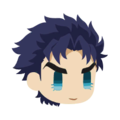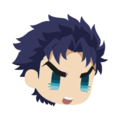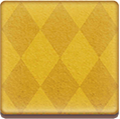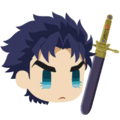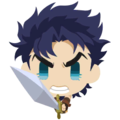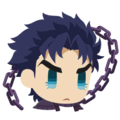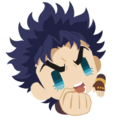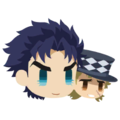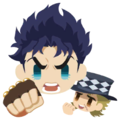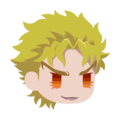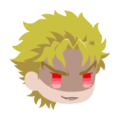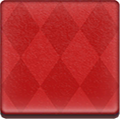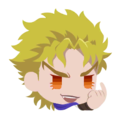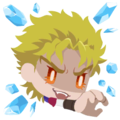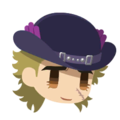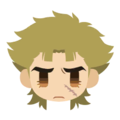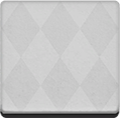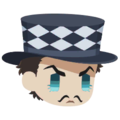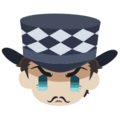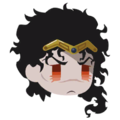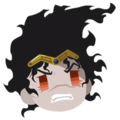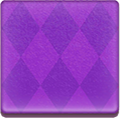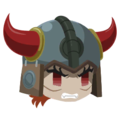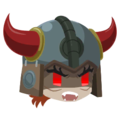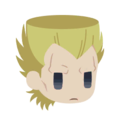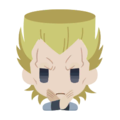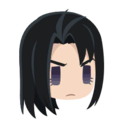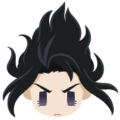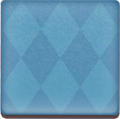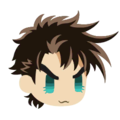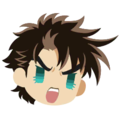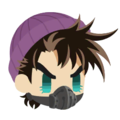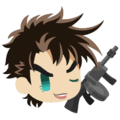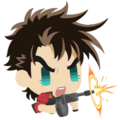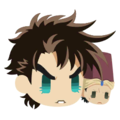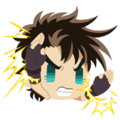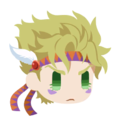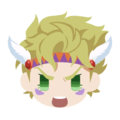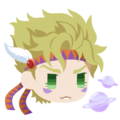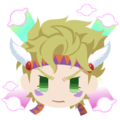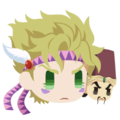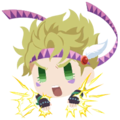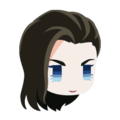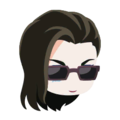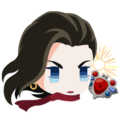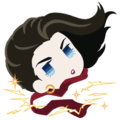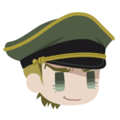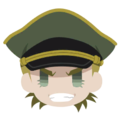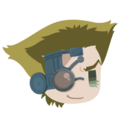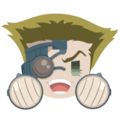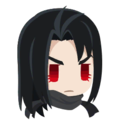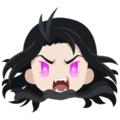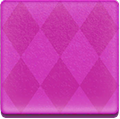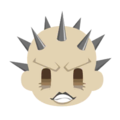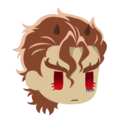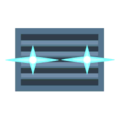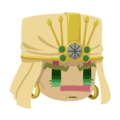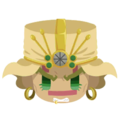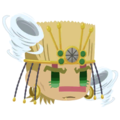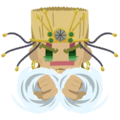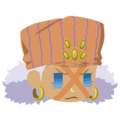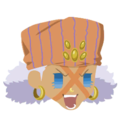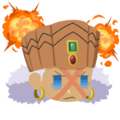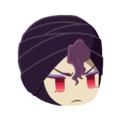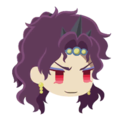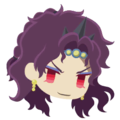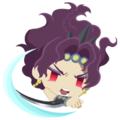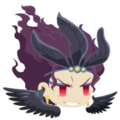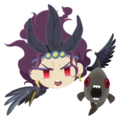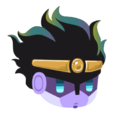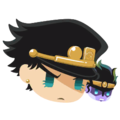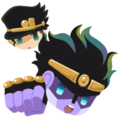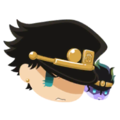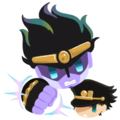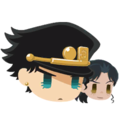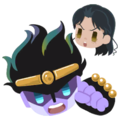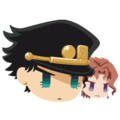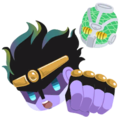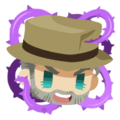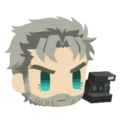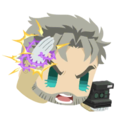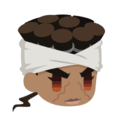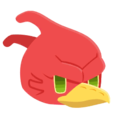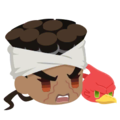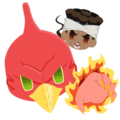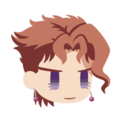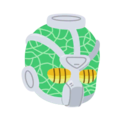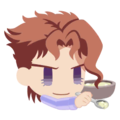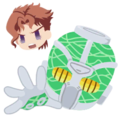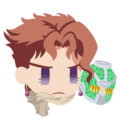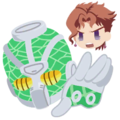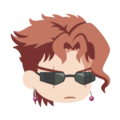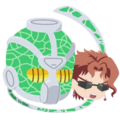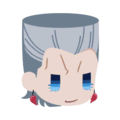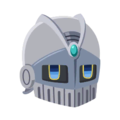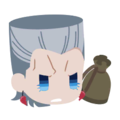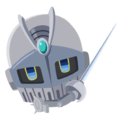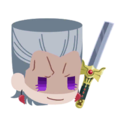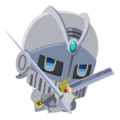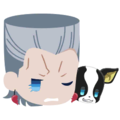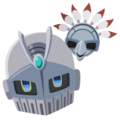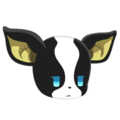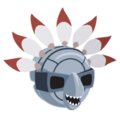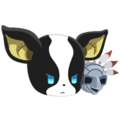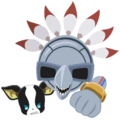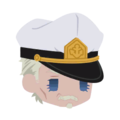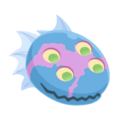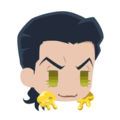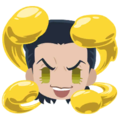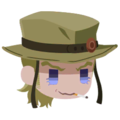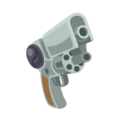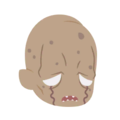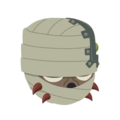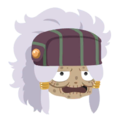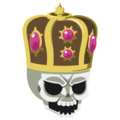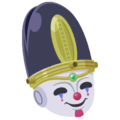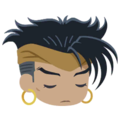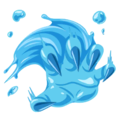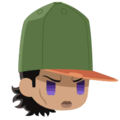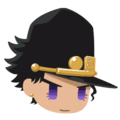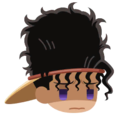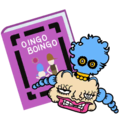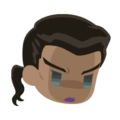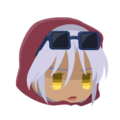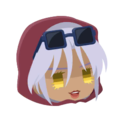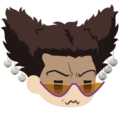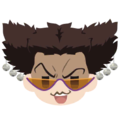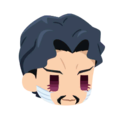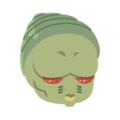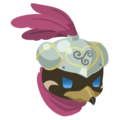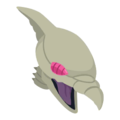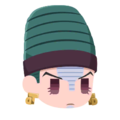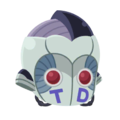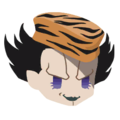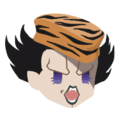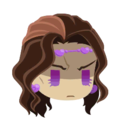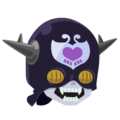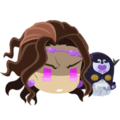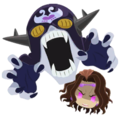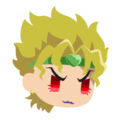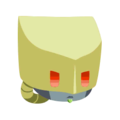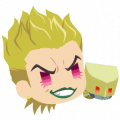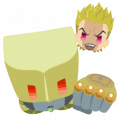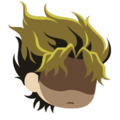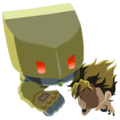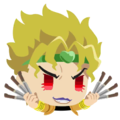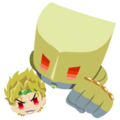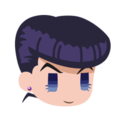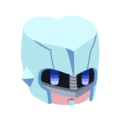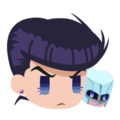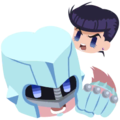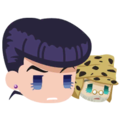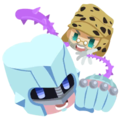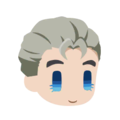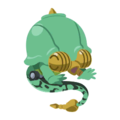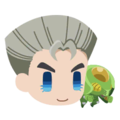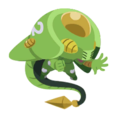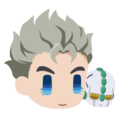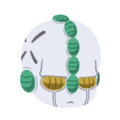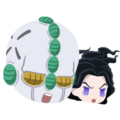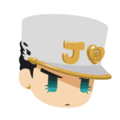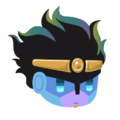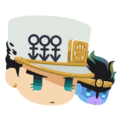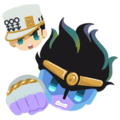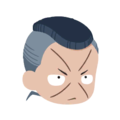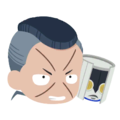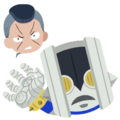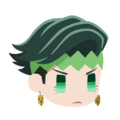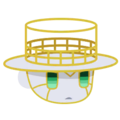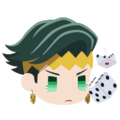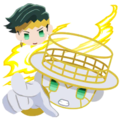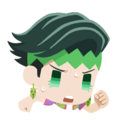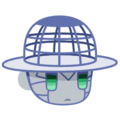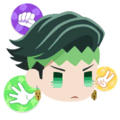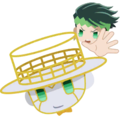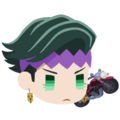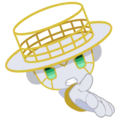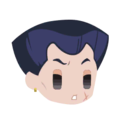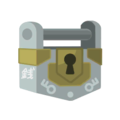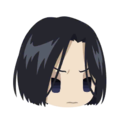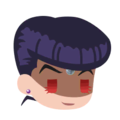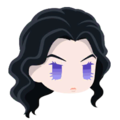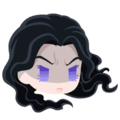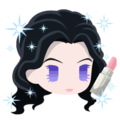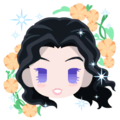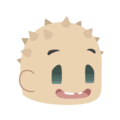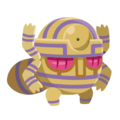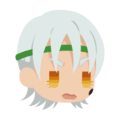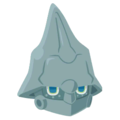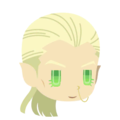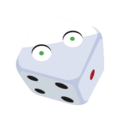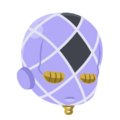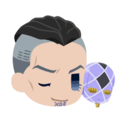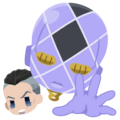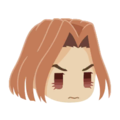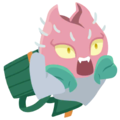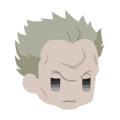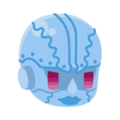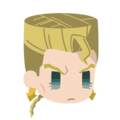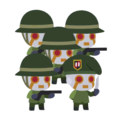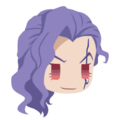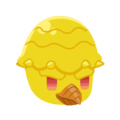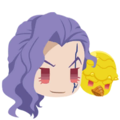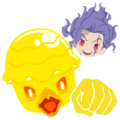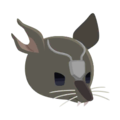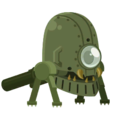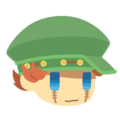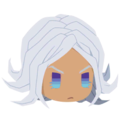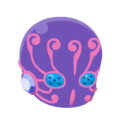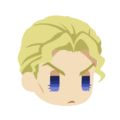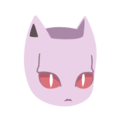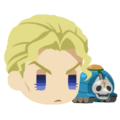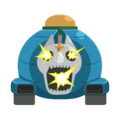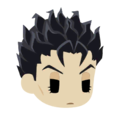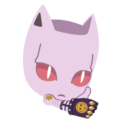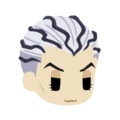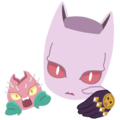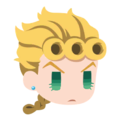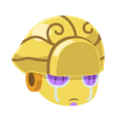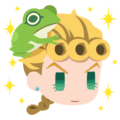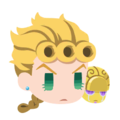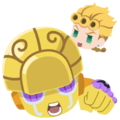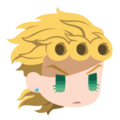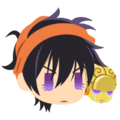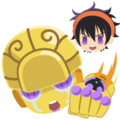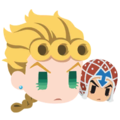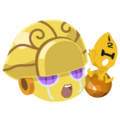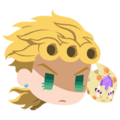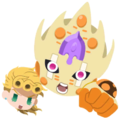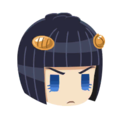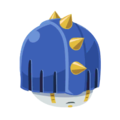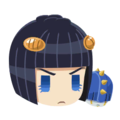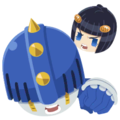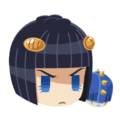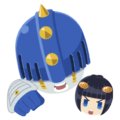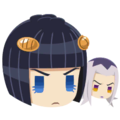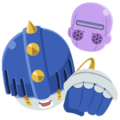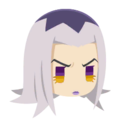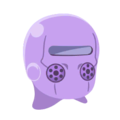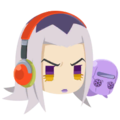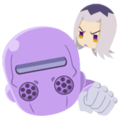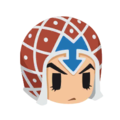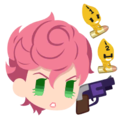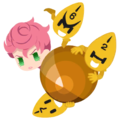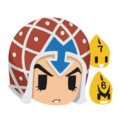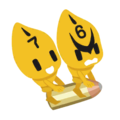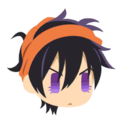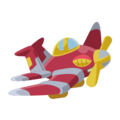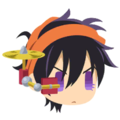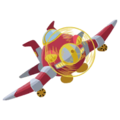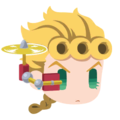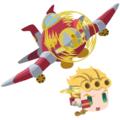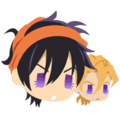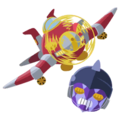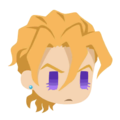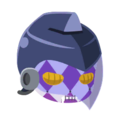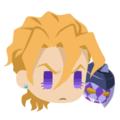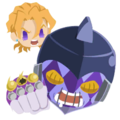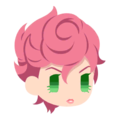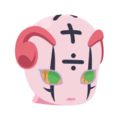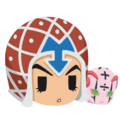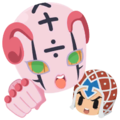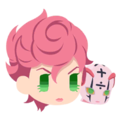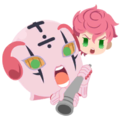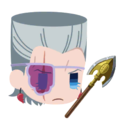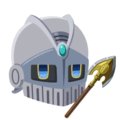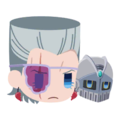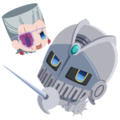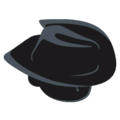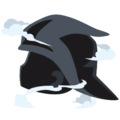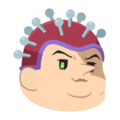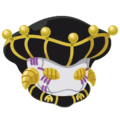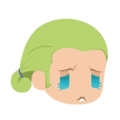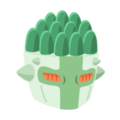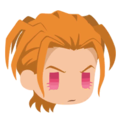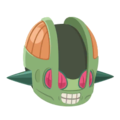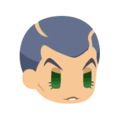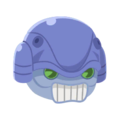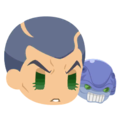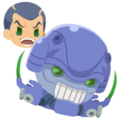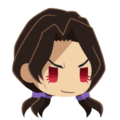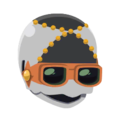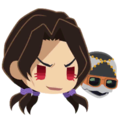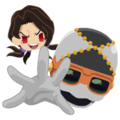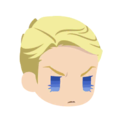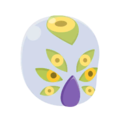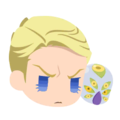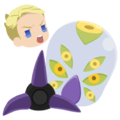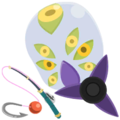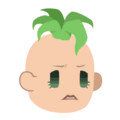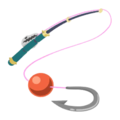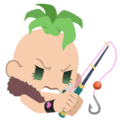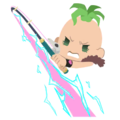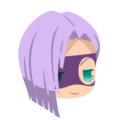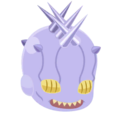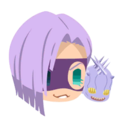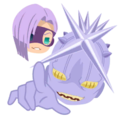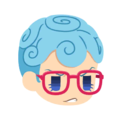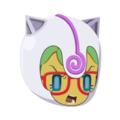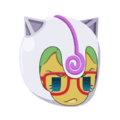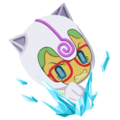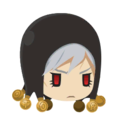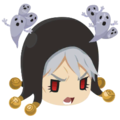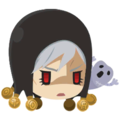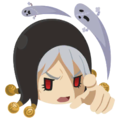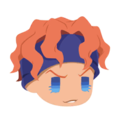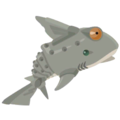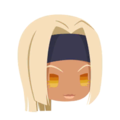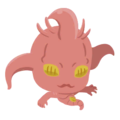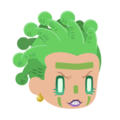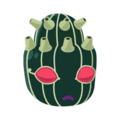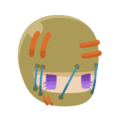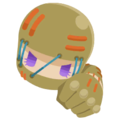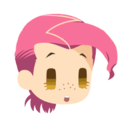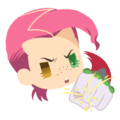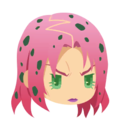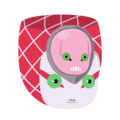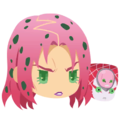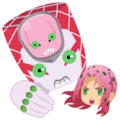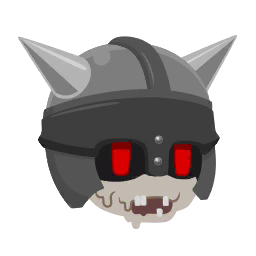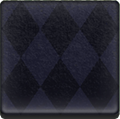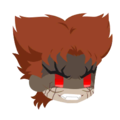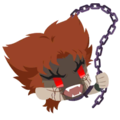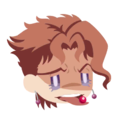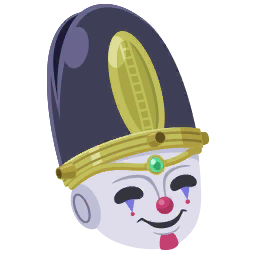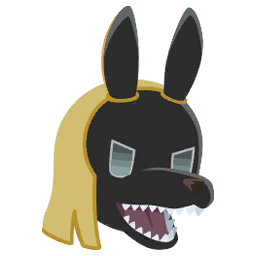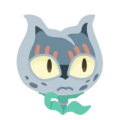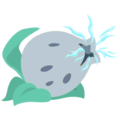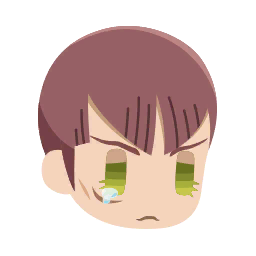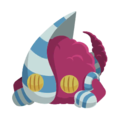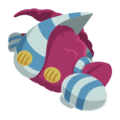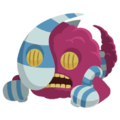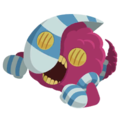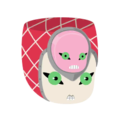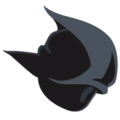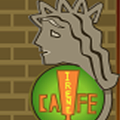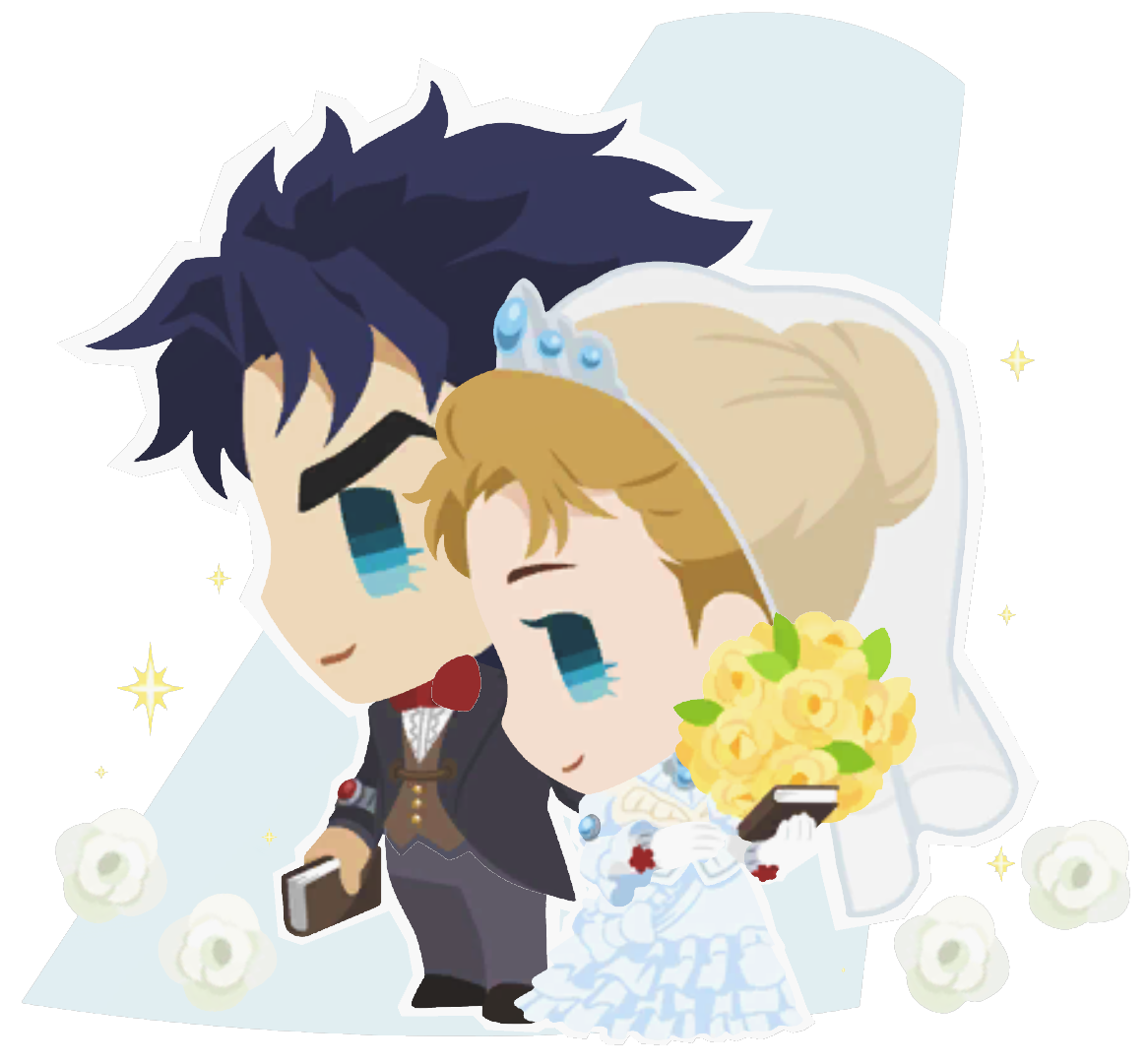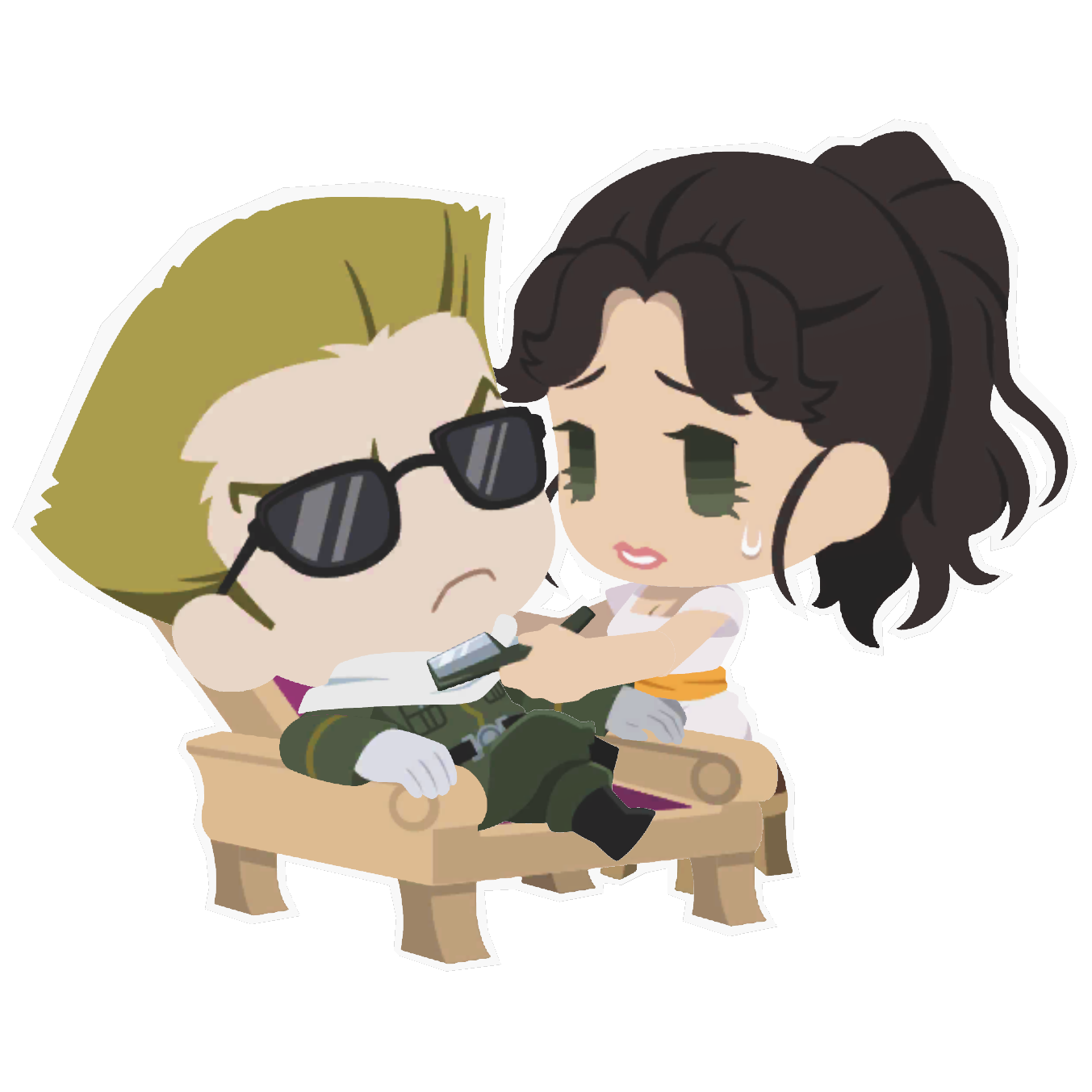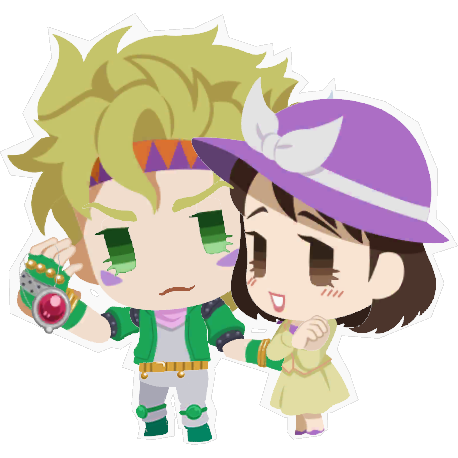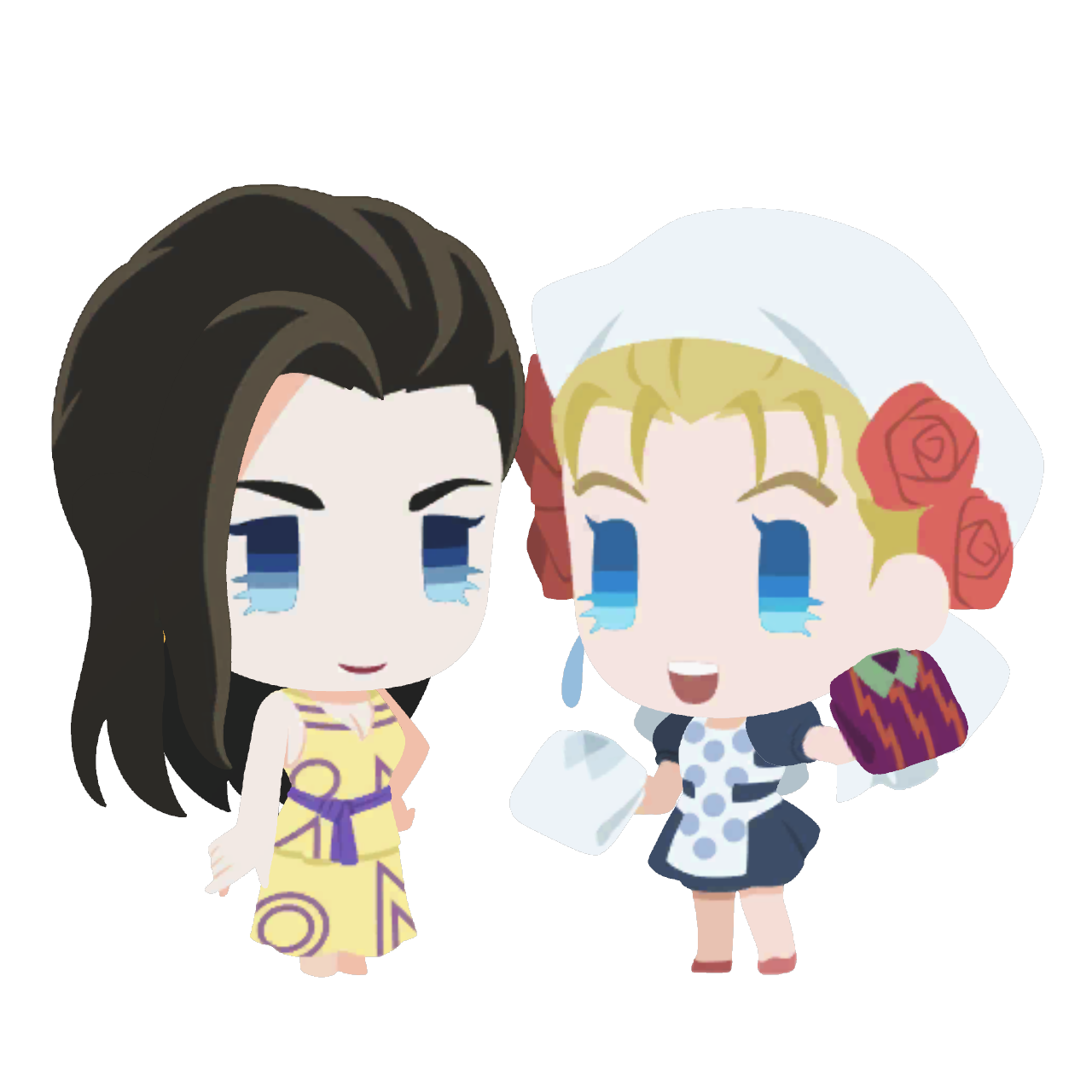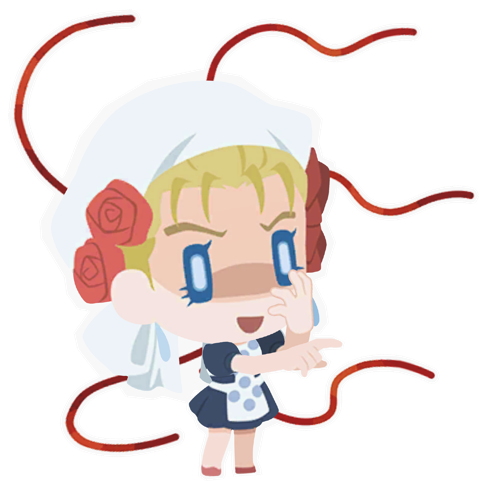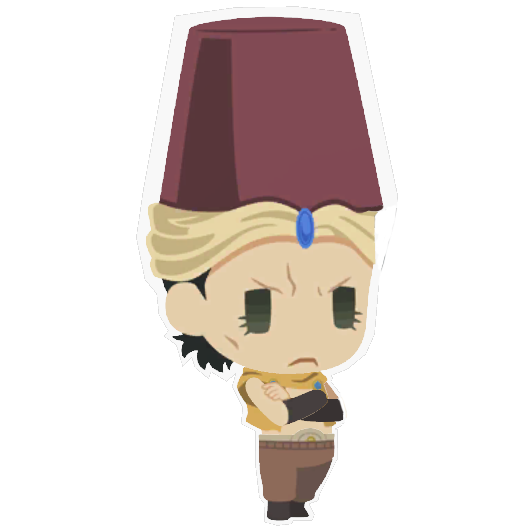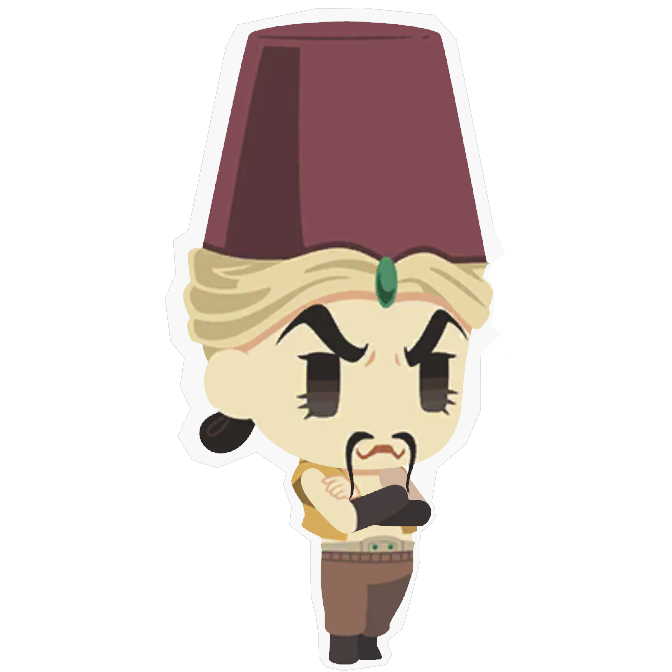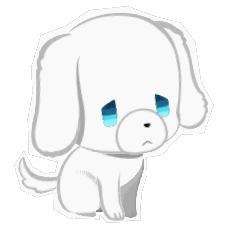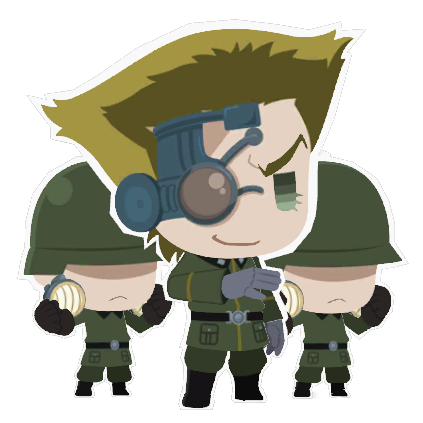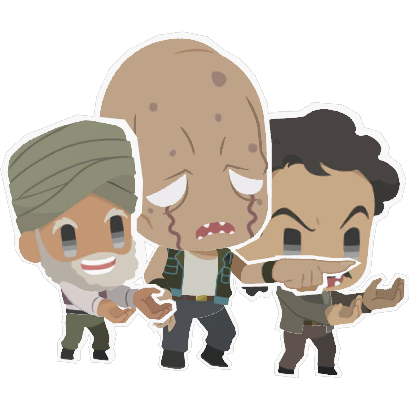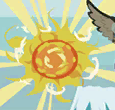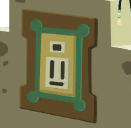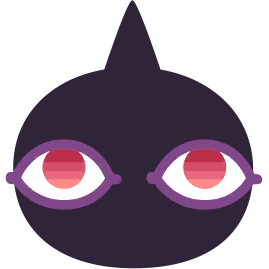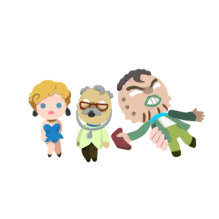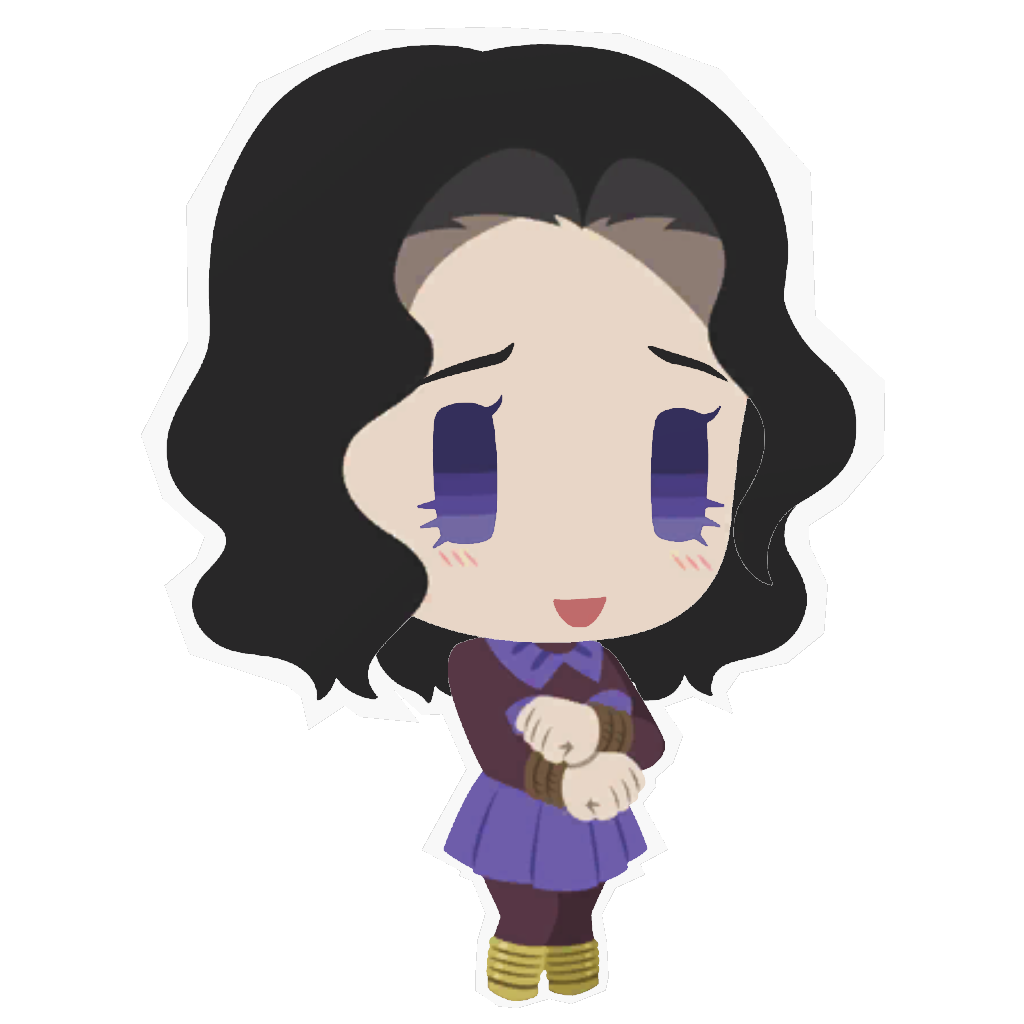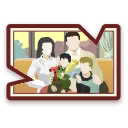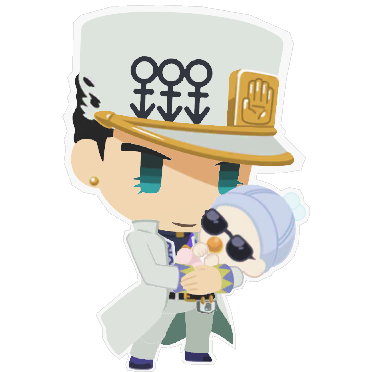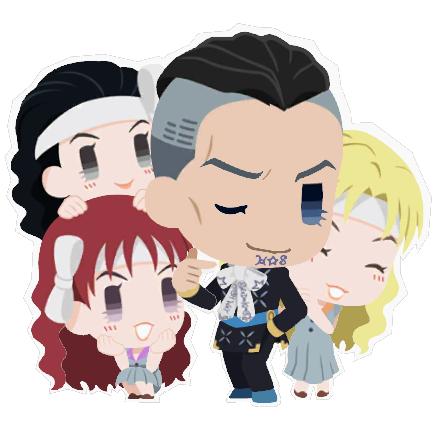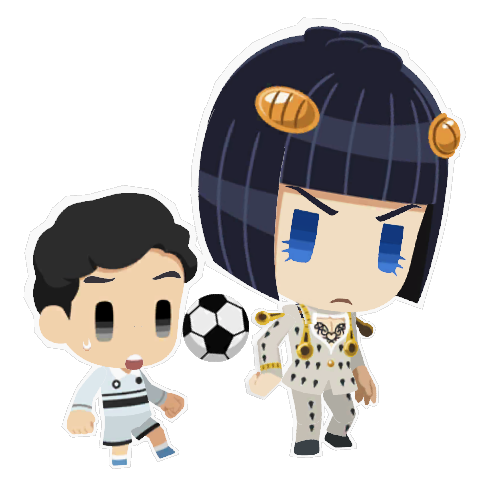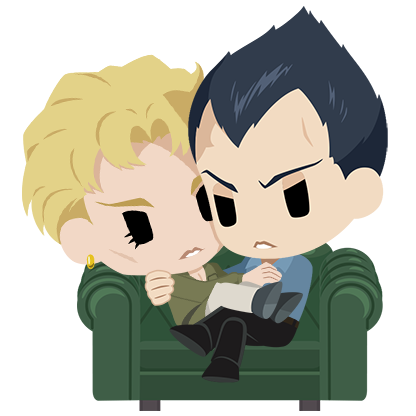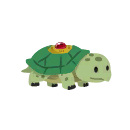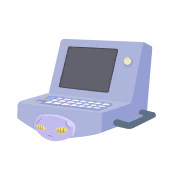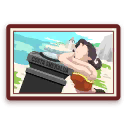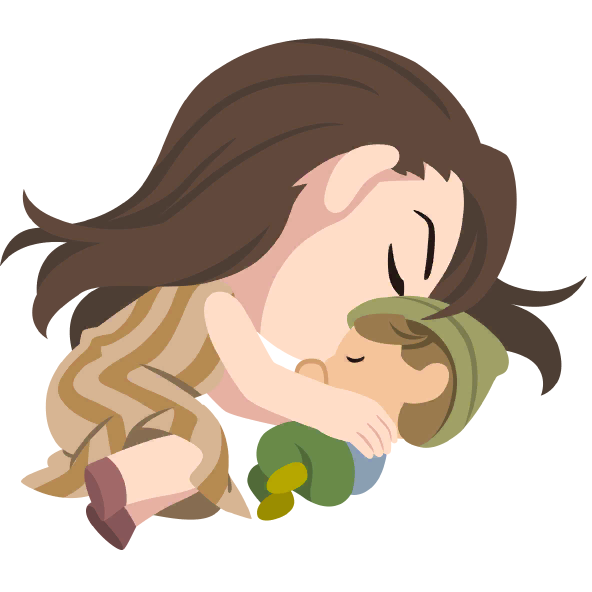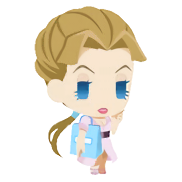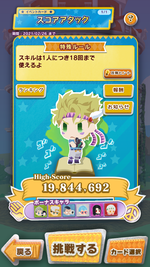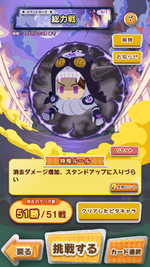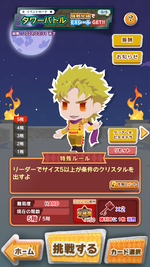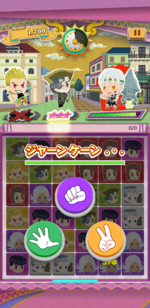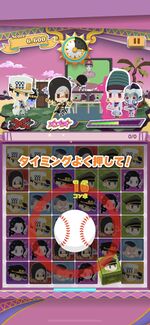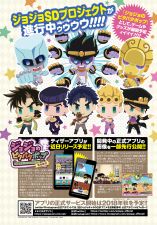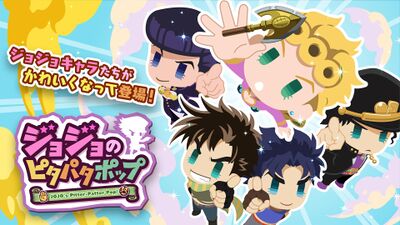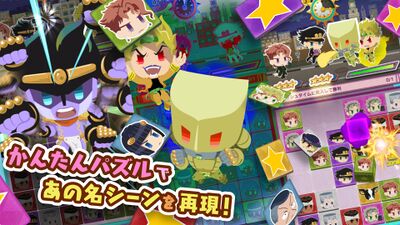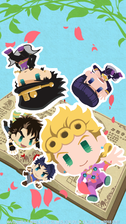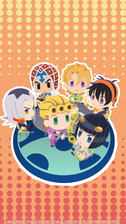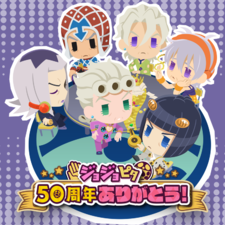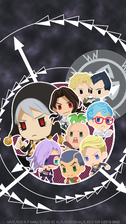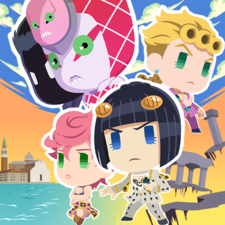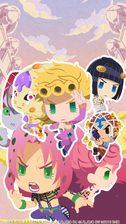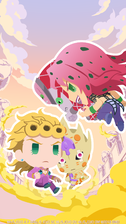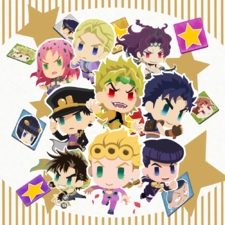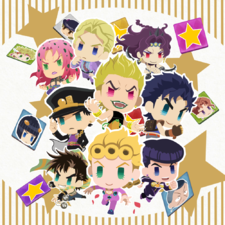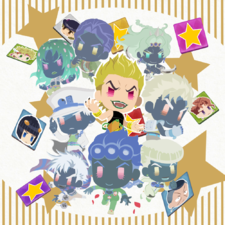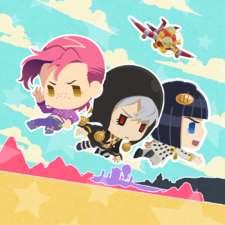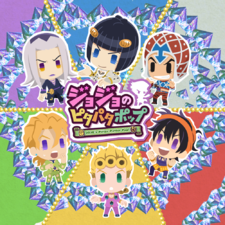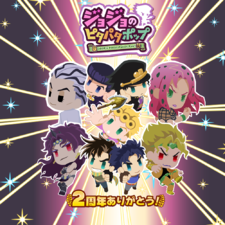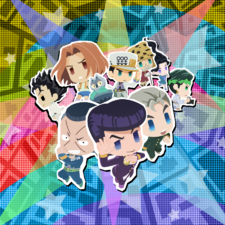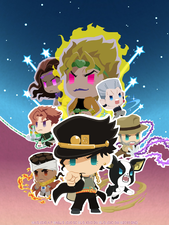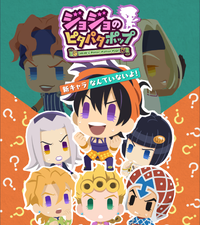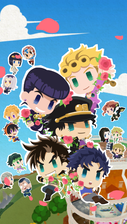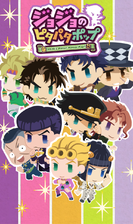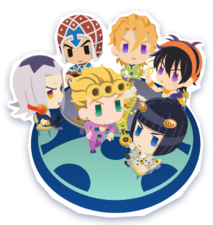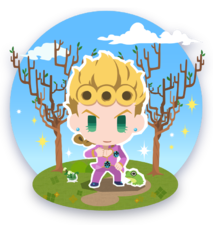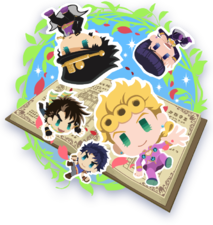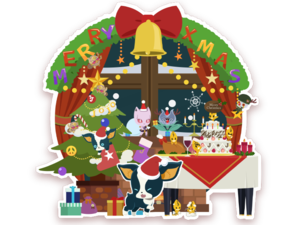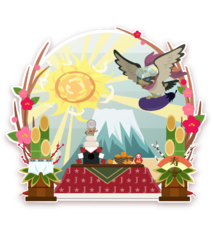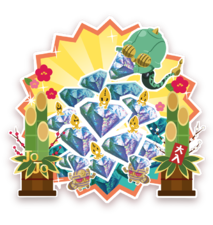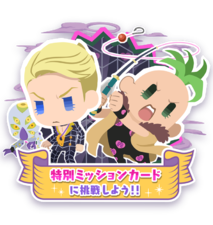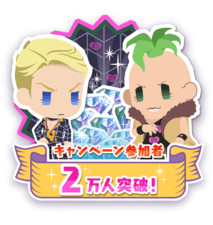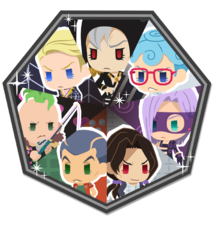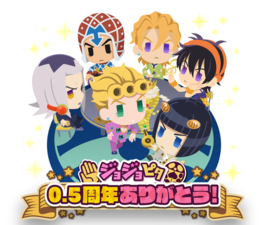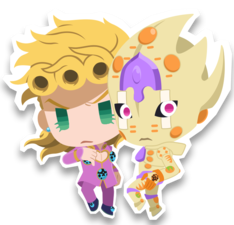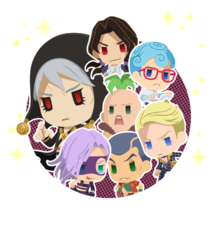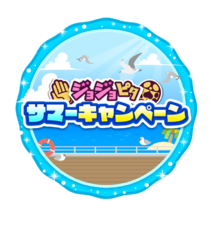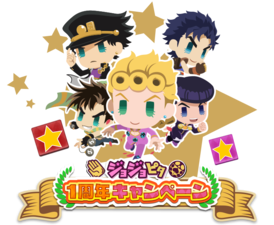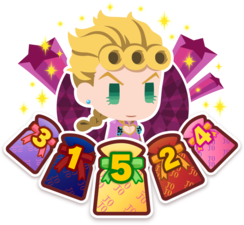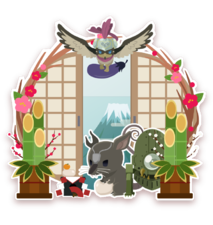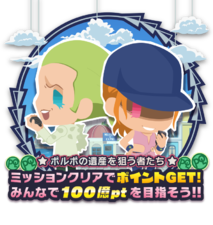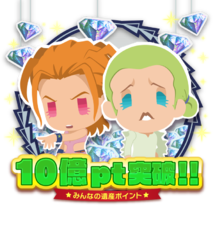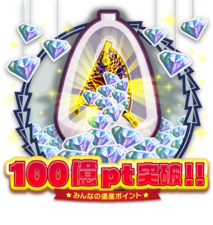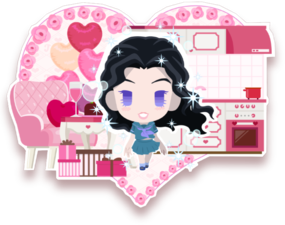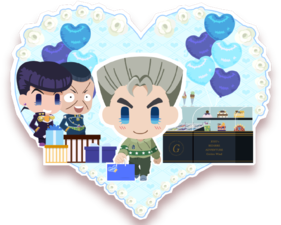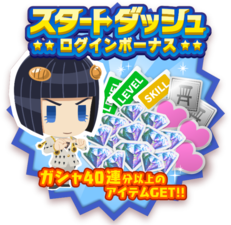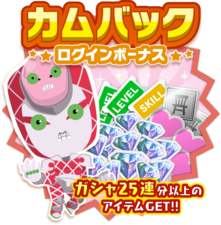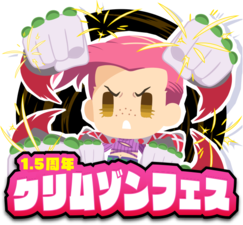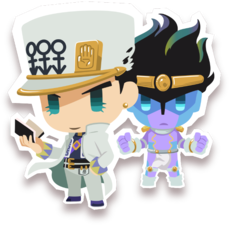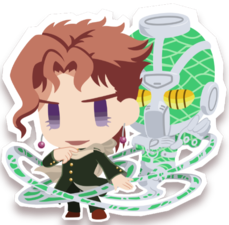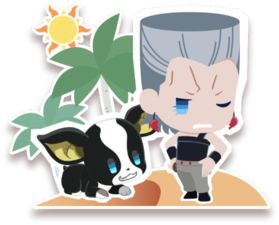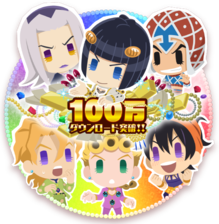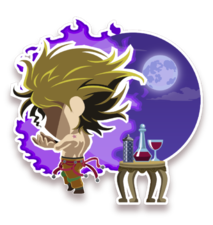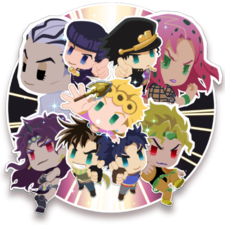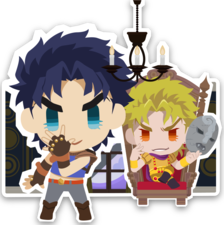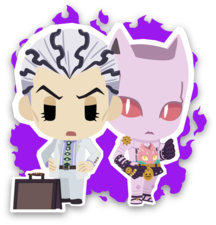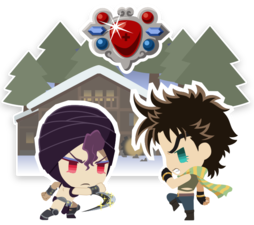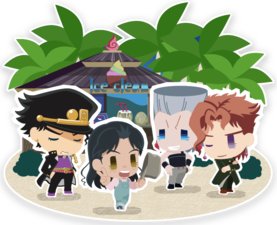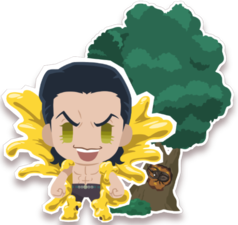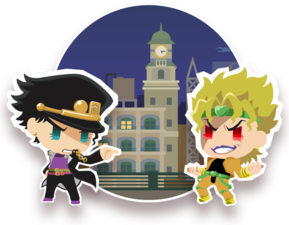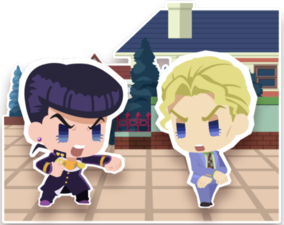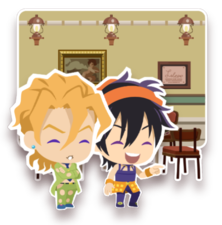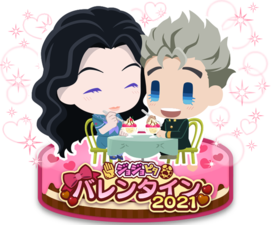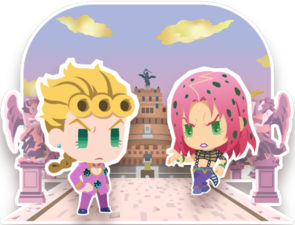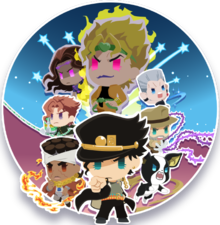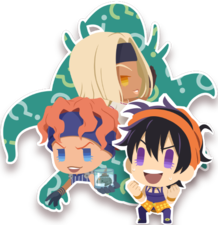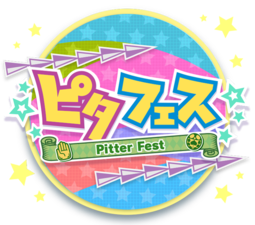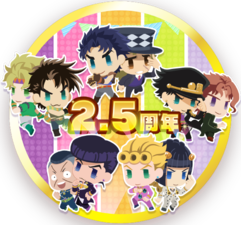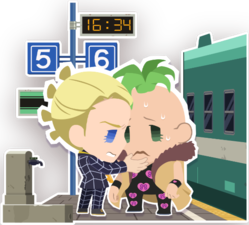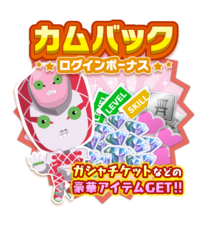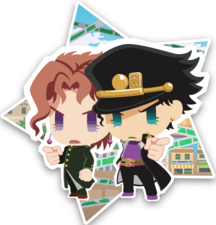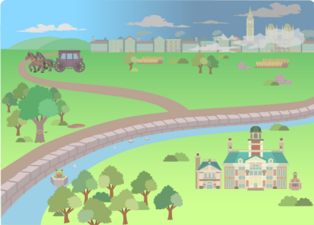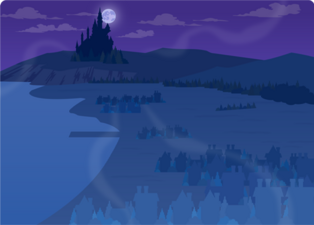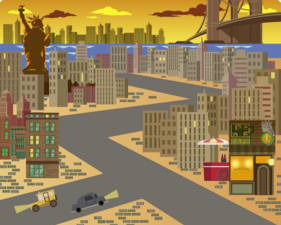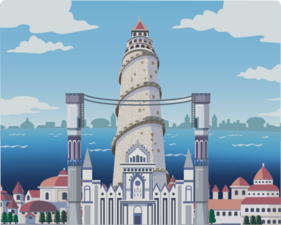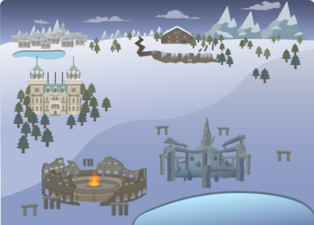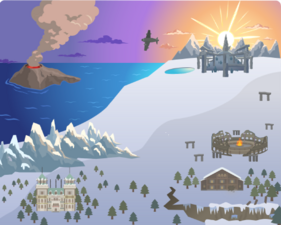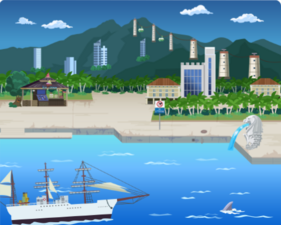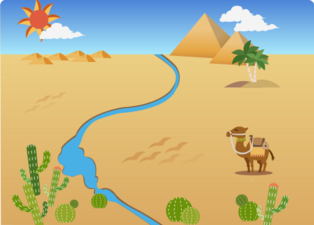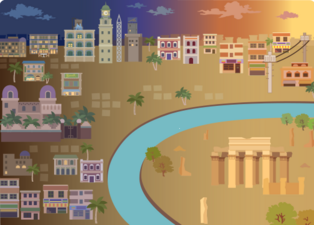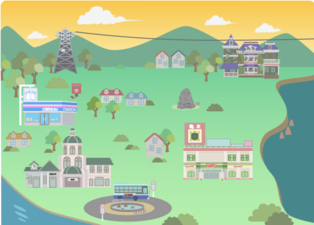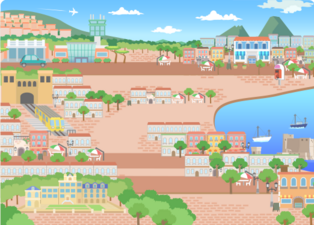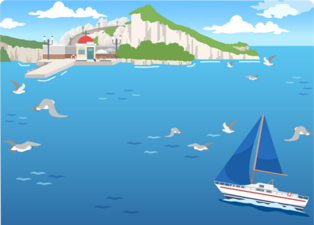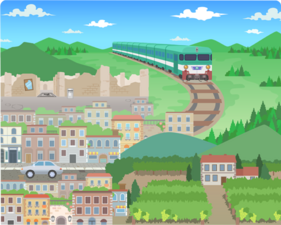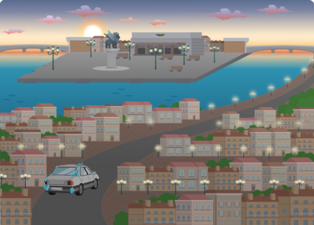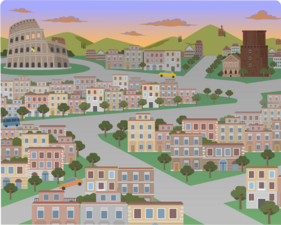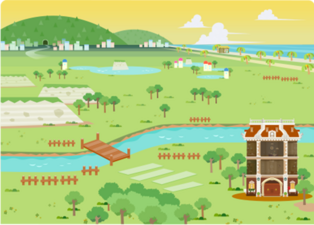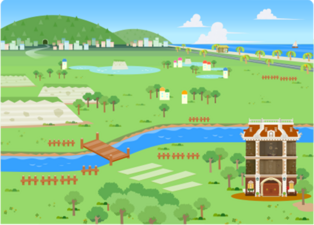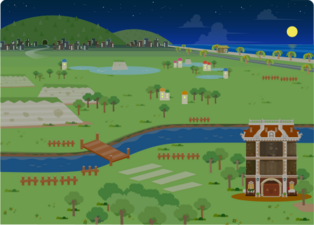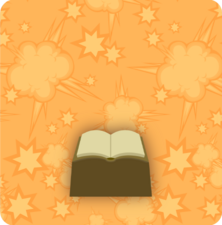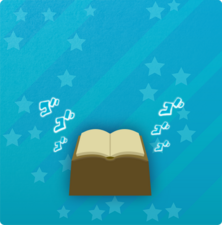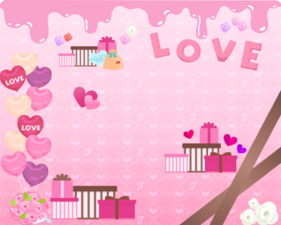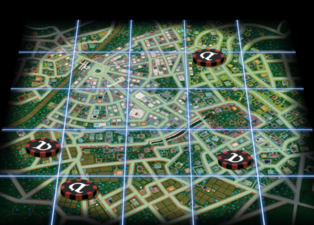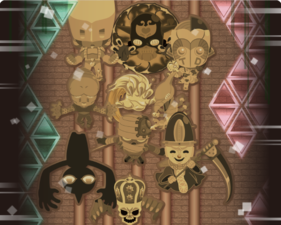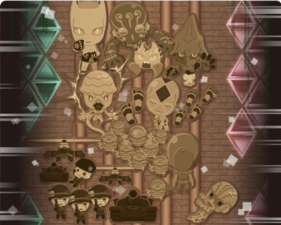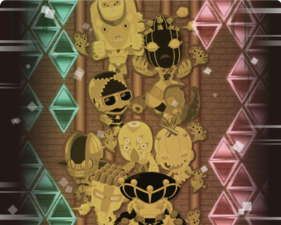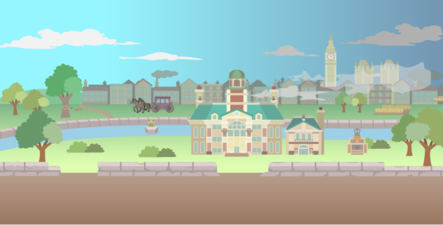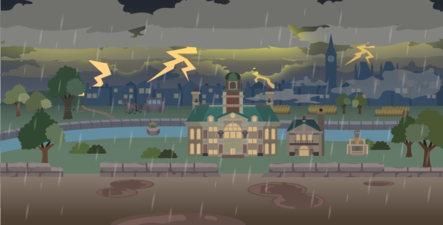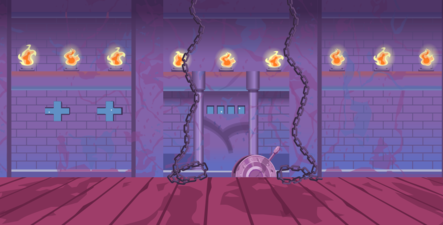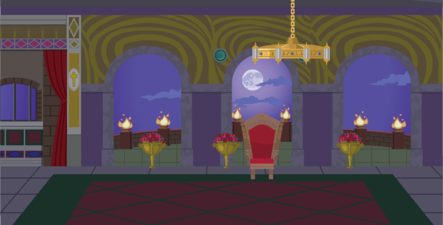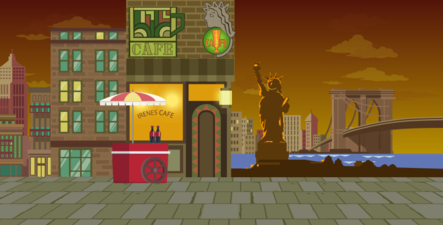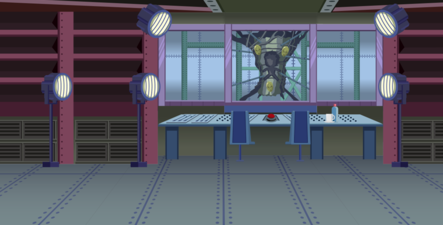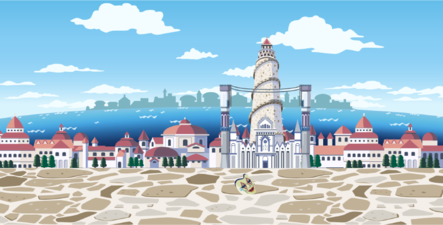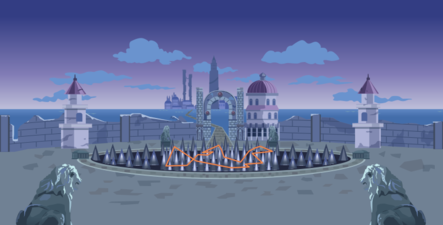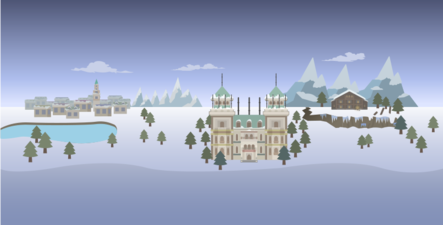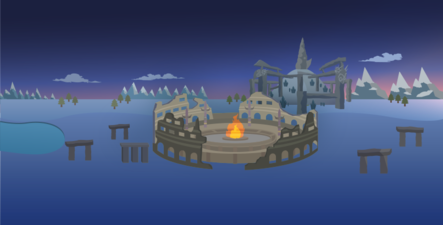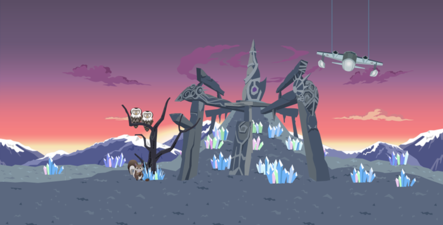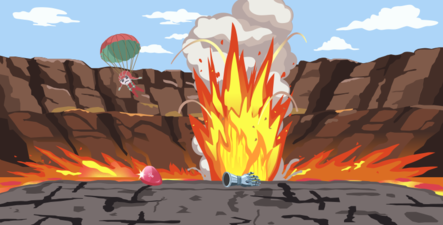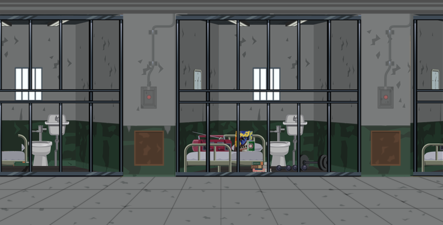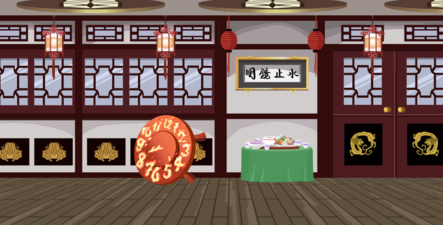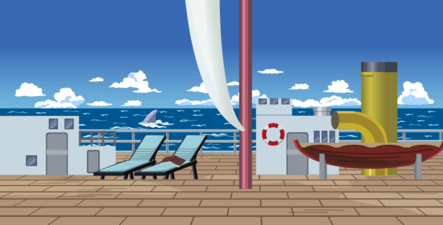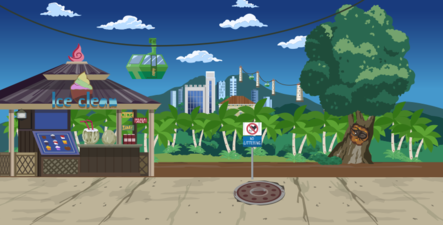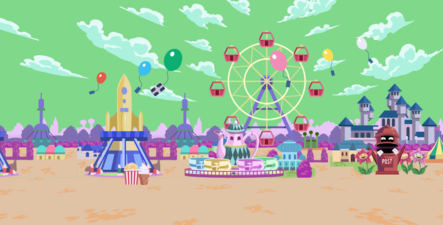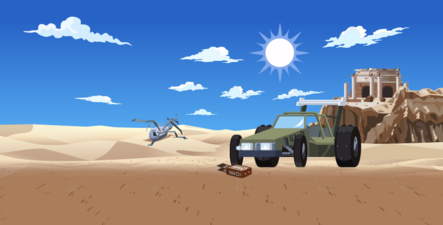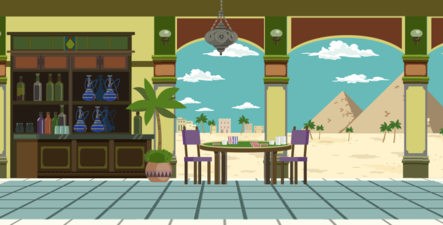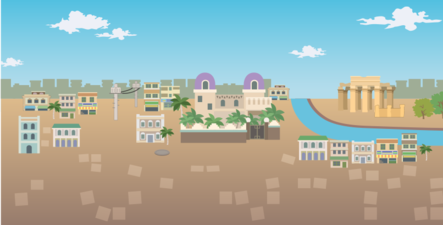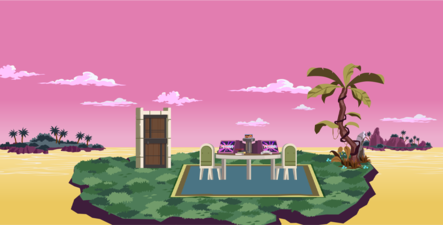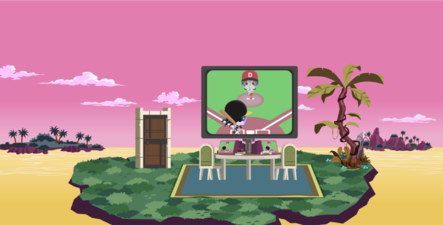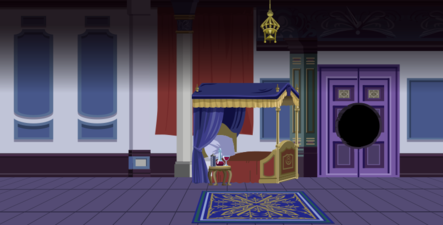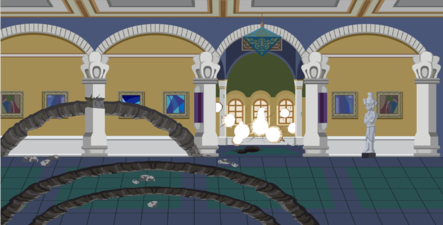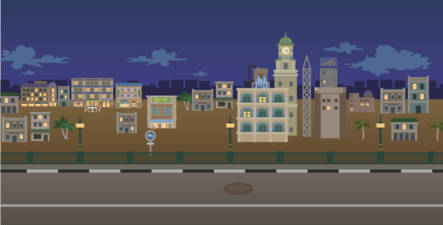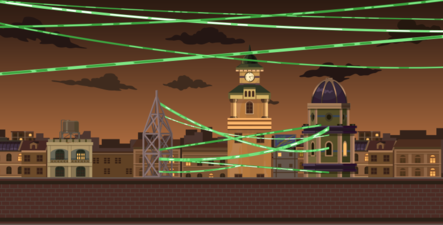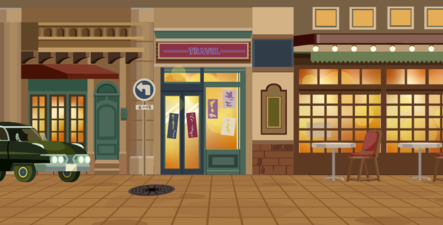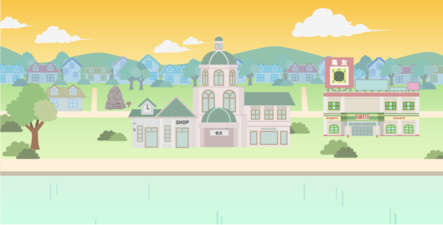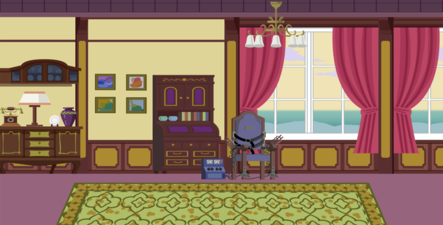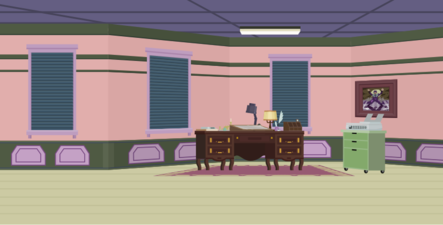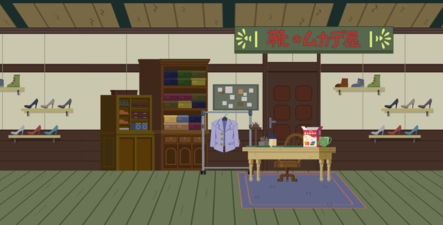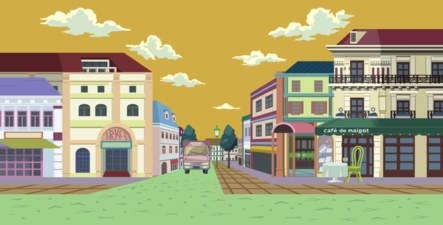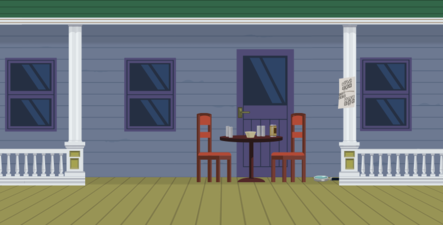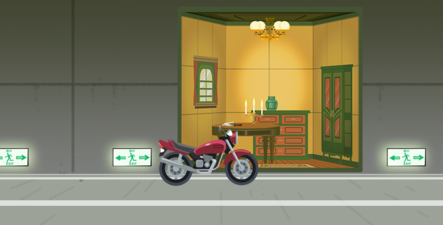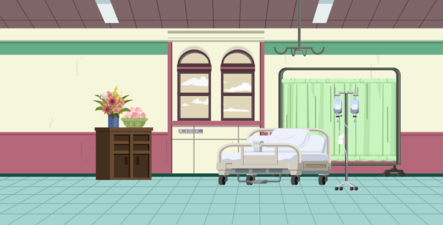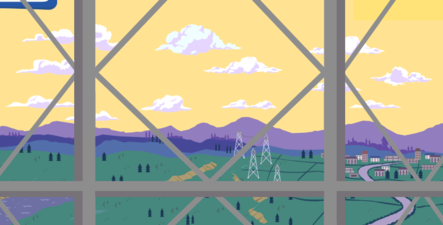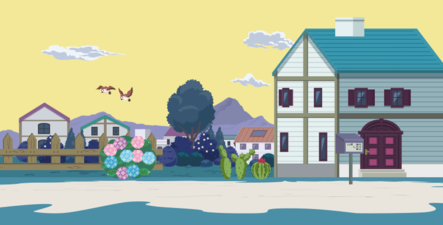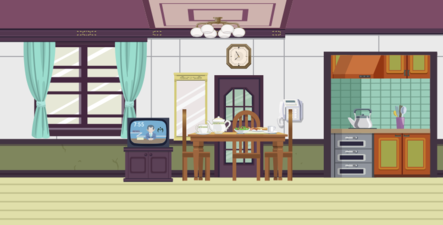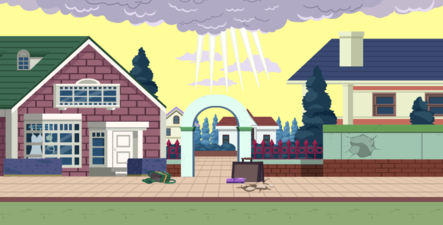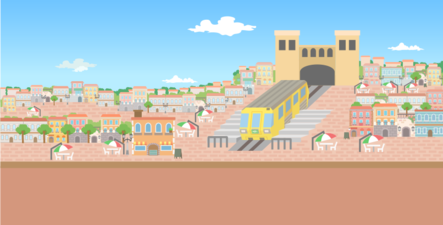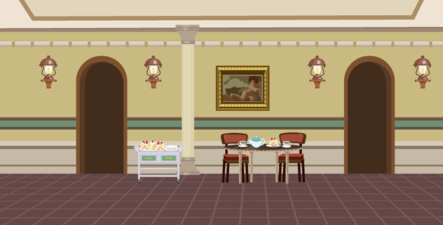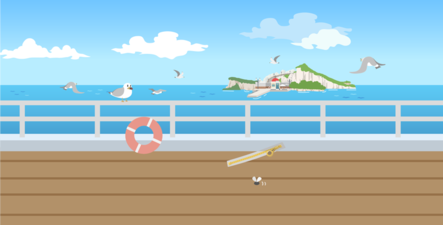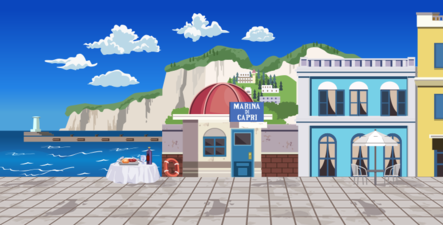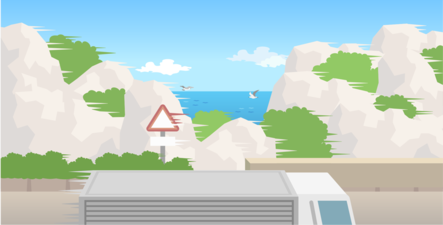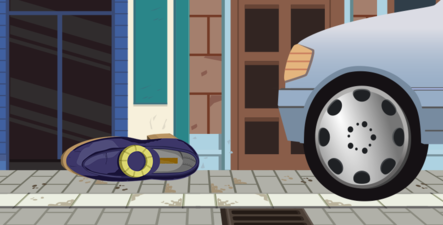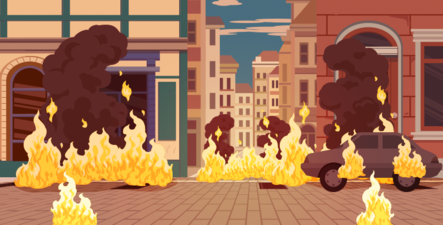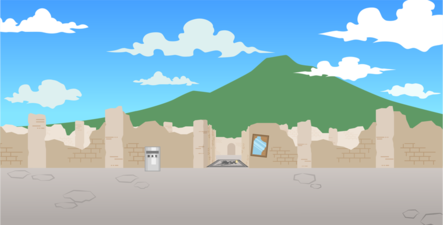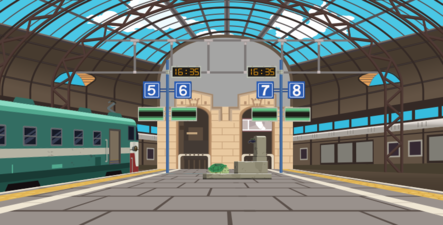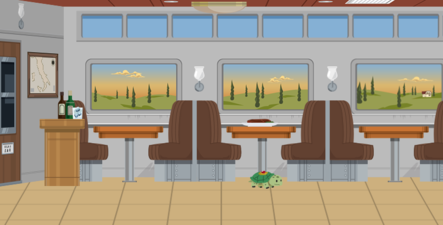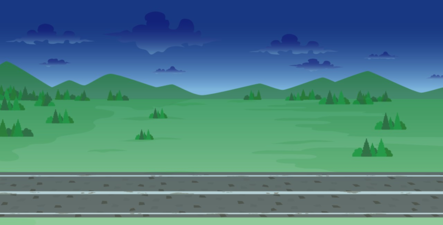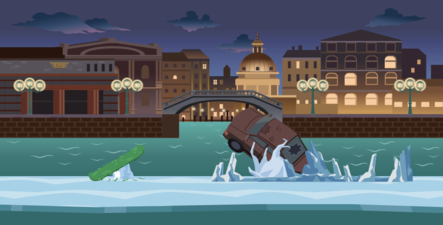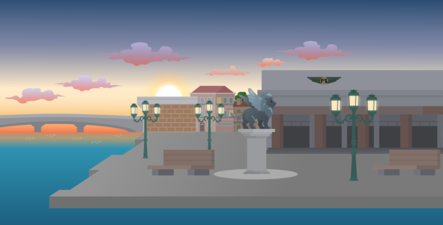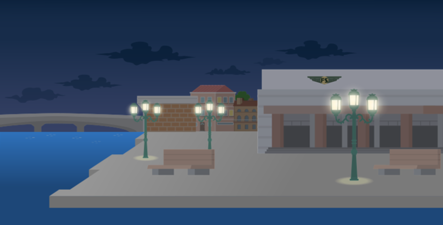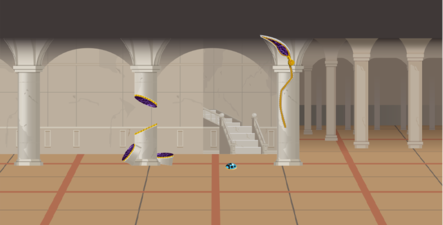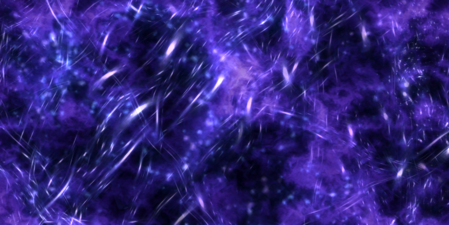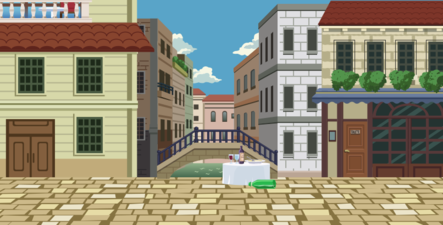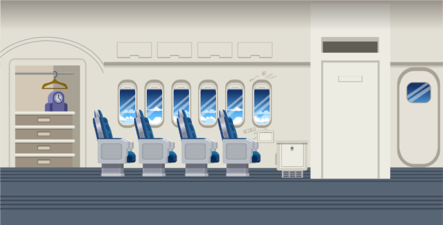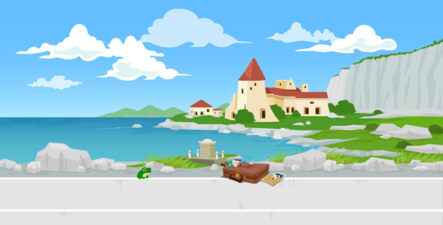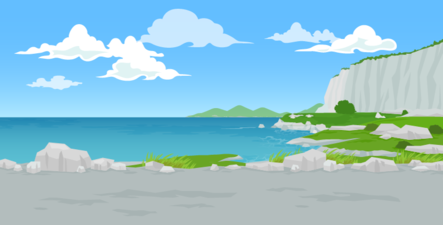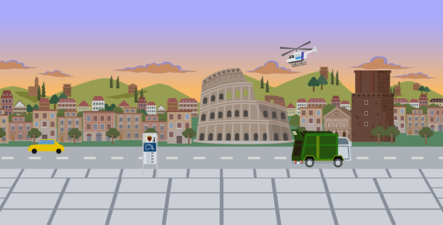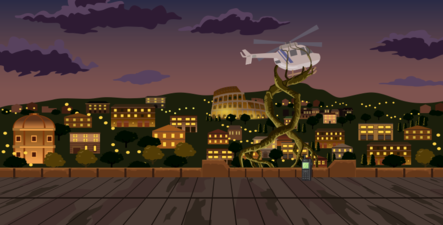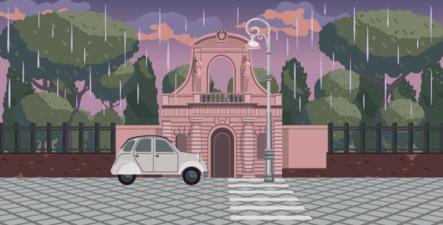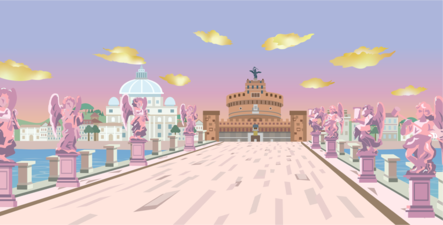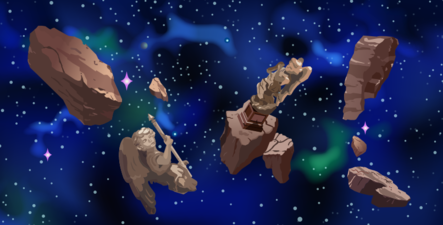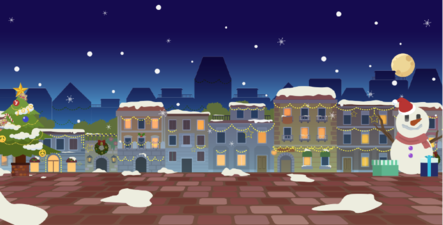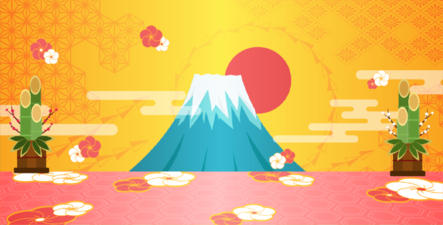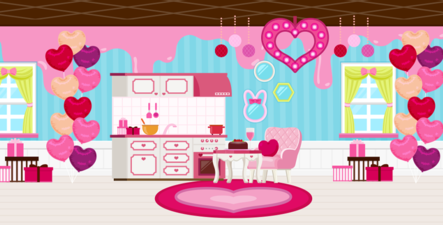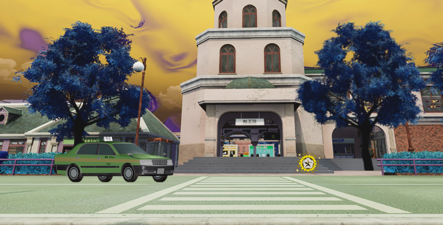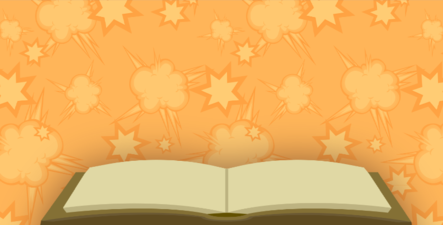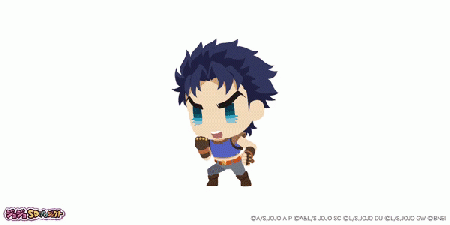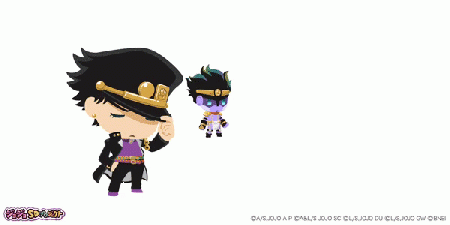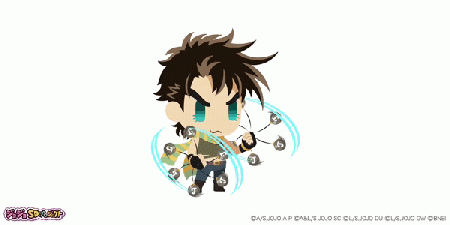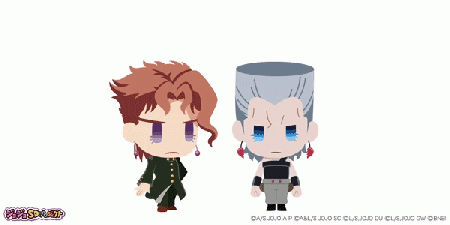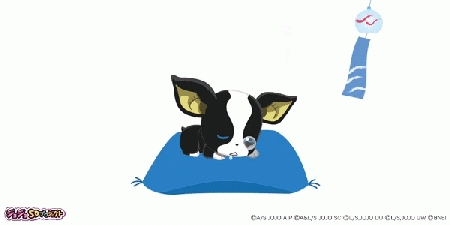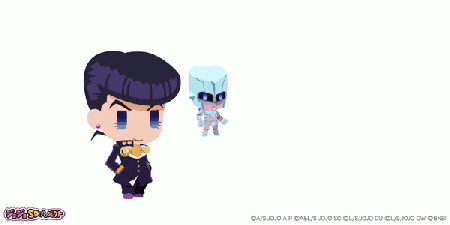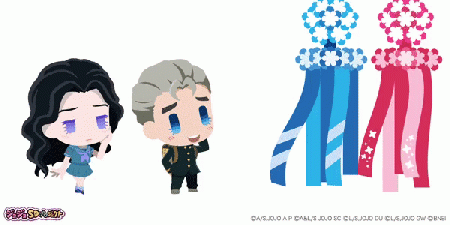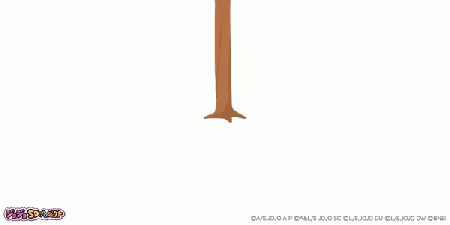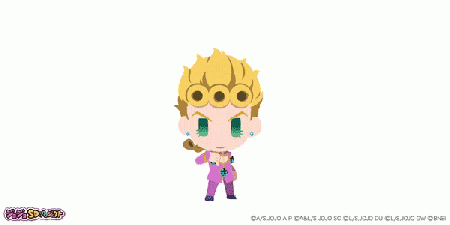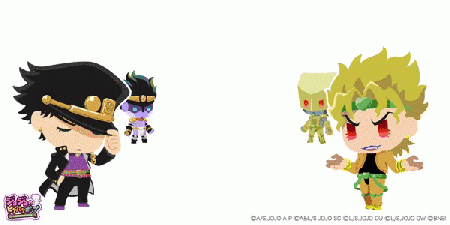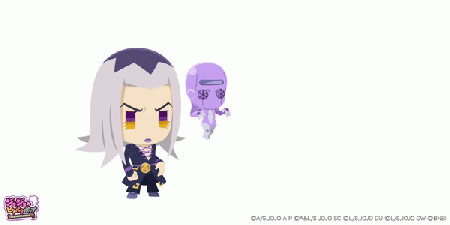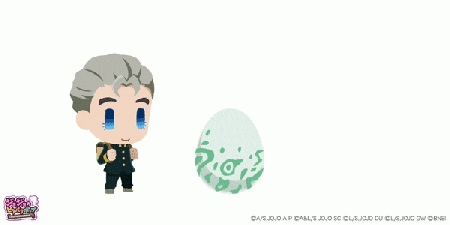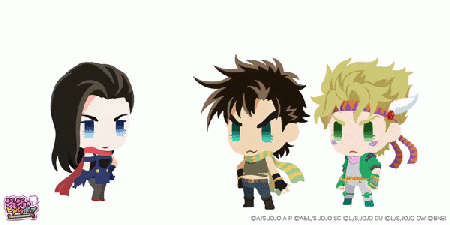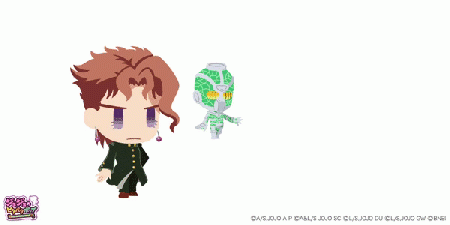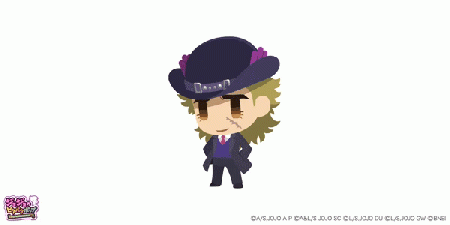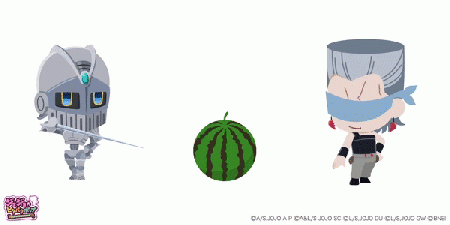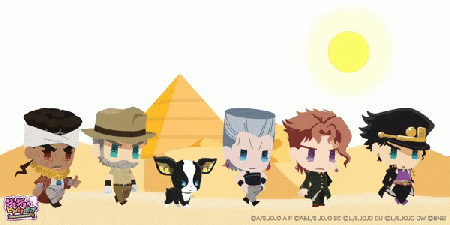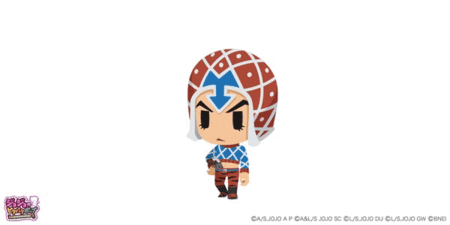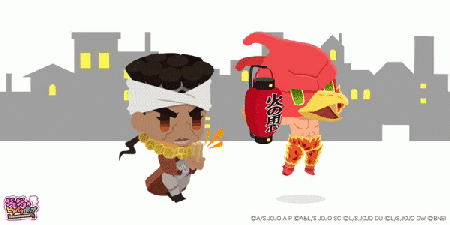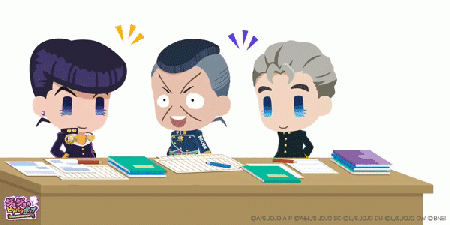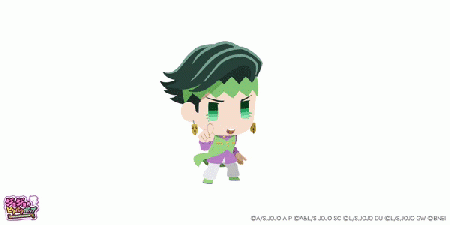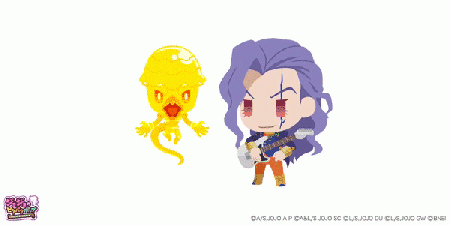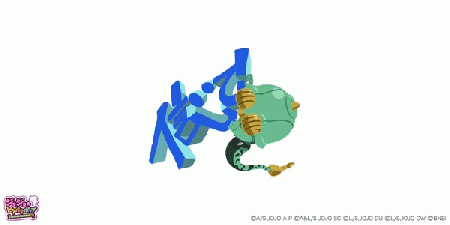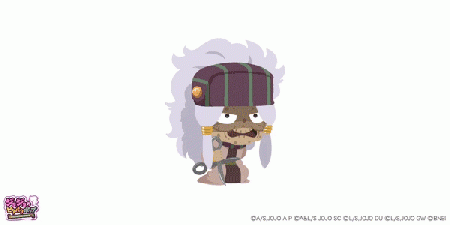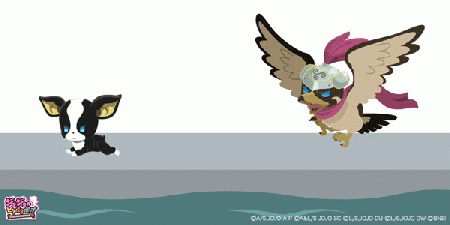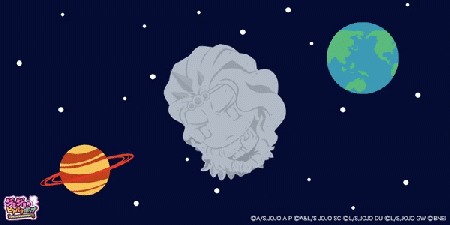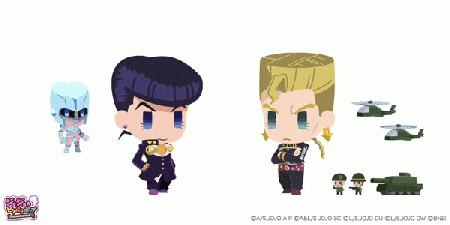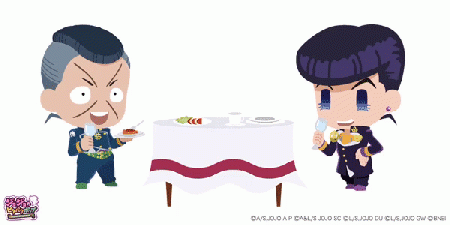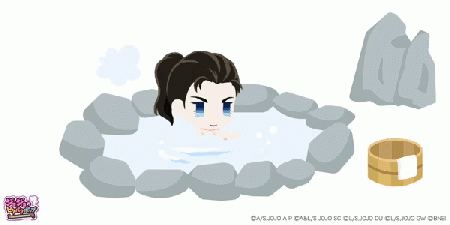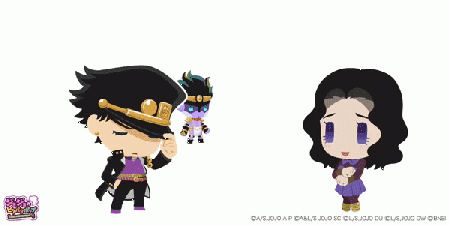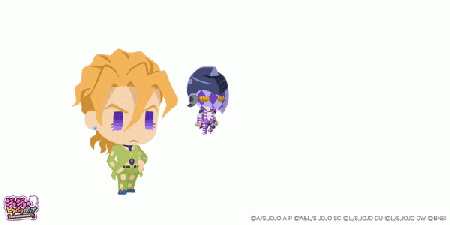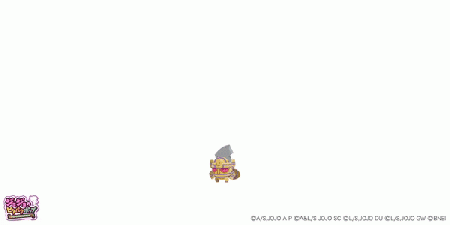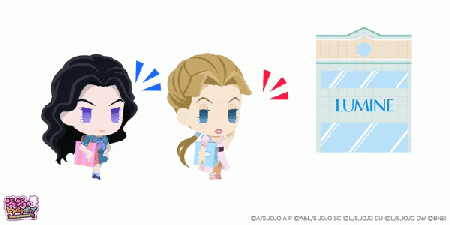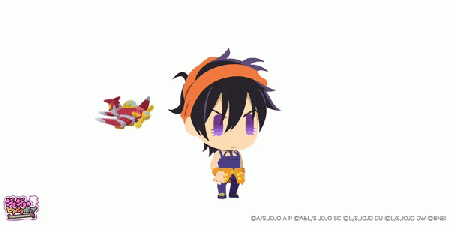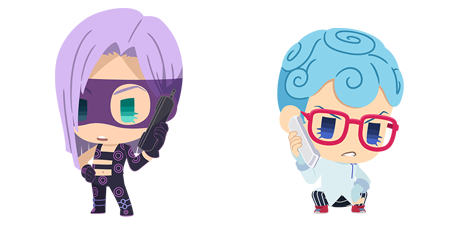JoJo's Pitter-Patter Pop! (ジョジョのピタパタポップ, JoJo no Pita Pata Poppu) was a mobile puzzle game released on October 10, 2018. The game was part of the JoJo SD Project (ジョジョSDプロジェクト, JoJo SD Purojekuto) and was first teased alongside the announcement of JoJo's Bizarre Adventure: Golden Wind.[1]
Pitter-Patter Pop! was revealed in the September 2018 issue of Ultra Jump on August 17, 2018, and features "super-deformed" (SD) artwork of characters from the JoJo's Bizarre Adventure series.
Before the game released, Bandai Namco previewed the characters in a teaser app called "JoJo's Pitter-Patter Pop! Chiramise" (ジョジョのピタパタポップ ちらみせ) on August 27, 2018. It was a sneak peek that allowed users to take photos with the SD characters appearing in different poses, though the full game was much different.[2]
On July 2, 2021, it was announced that the game will no longer be available to play. The purchase of Diamonds was available until August 2, 2021, and the game's servers officially closed down on September 2, 2021.
Battle Gameplay
JoJo's Pitter-Patter Pop! is a tile-matching video game featuring characters from the first five parts of the series: Phantom Blood, Battle Tendency, Stardust Crusaders, Diamond is Unbreakable and Vento Aureo.
Tile-Matching
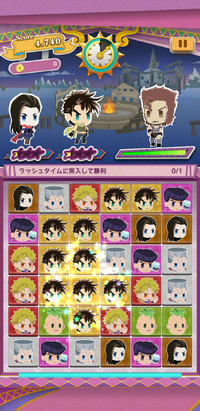
The top of the screen shows two characters the player controls (such as Giorno and Bucciarati) who face off against a boss character (e.g. Leaky-Eye Luca) with a health bar. The rest of the screen displays a 6x6 grid consisting of icons of many different characters. Players will have to match the tiles to make them fold and then disappear, which increases their score and decreases the health of the boss. Matching over 6 tiles at once will create a box of that tile, which can be moved just like other tiles and tapped on to open, creating 5 tiles in a cross shape. Tiles made by a box cannot create an another box. By matching fast the player earns combo, which increases the damage every 10 combo gained, maxing out at 200 combo. The player is unable to lose combo if in stopped time or stand up time. The battle ends when the boss is defeated or time runs out.
Stand-up Time
Matching and erasing tiles over time will build up the "Stand-up Time" meter and skill gauges for the two characters in the team. The Stand-up Time meter is a blue meter around the grid. Once full, the player temporarily enters Stand-up Time, during which the timer is stopped and matched tiles remain on the board and flip over, allowing the player to build up their combo. Making squares of tiles (up to a 6x6) multiplies the damage. Once Stand-up Time is over, all matched tiles will disappear doing an equivalent amount of damage to the boss, normal gameplay resumes and the meter resets.
Rush Time
If time runs out or the boss is defeated and a character has full meter, all tiles of that character will get erased, adding points and damaging the boss if they have any health left. Any boxes left untapped will open, also adding points and dealing damage if a match is created. If the boss is defeated within a given amount of time, "Rush Time" activates, and the player can repeatedly strike the boss by quickly matching icons to rack up their score and earn additional coins. Once entering Rush Time special tiles and obstacles will disappear (with a few exceptions). Certain characters passive effects stay active in Rush Time.
Skills
Below each character is a skill gauge in the form of three stars. Once a character's skill gauge is full, their skill can be activated by tapping the character. All characters possess unique skills with different effects falling into one of four categories. "Replace" (変化, Henka) skills replace tiles with others, usually of those of the character activating it. "Enhance" (強化, Kyōka) skills buff tiles by either enchancing or intensifying them. Matching or erasing enchanced tiles grants more damage and skill charge, matching or erasing intensified panels grants only a big amount of damage. "Erase" (消去, Shōkyo) skills remove tiles without needing to match them, dealing multiplied damage dependant on the unit. "?" skills are skills that do not fall into any of the previous categories, such as rearranging tiles, stopping the timer, or a combination of multiple categories.
Later, "Boost" (ブースト, Būsuto) skills were introduced which a unit may have in addition to one of the previous skills. These units have boost levels that increase each time the skill is used per battle up to 5.
Skills can be activated in battle and during Stand-up Time, but not in Rush Time or during stopped time (such as when DIO uses his skill). Each unit has five skill levels (excluding the limited Giorno Real Frog ver. which only has three) which determine the parameters of the skill and their cooldown. Cooldown determines how many tiles must be matched or erased for the skill to be used, which varies per character. It can be influenced by using enhanced tiles or matching tiles of the character used in the team. By raising the skill level of the character the cooldown of their skill can be lowered. Special Battles replace the skill gauge with a pink, mini-game gauge
Battle Items
Battle items are power-ups which the player can buy or use before a battle starts. The player can buy them with either diamonds or coins, changing the currency type with the small button on the right. The player can obtain battle items from chest drops or limited time challenges.

|
Increases damage by 10%. Costs 500 coins or 2 diamonds |

|
Coins earned multiplied by 2.5. Costs 500 coins or 2 diamonds |

|
Adds 5 seconds to the clock. Costs 1000 coins or 4 diamonds |

|
Grants the leader a charged skill from the start of the match. Costs 2000 coins or 8 diamonds |
Panel Types
There are many different panel types that different characters and bosses can create.
Mansion Gameplay
Progression
Four types of in game currency exist: Coins, Diamonds, Furniture Points, and Furniture Tickets. These currencies can earned by completing missions for levels and daily quests. Coins and furniture points can also be earned by playing through levels themselves. Diamonds can be used to obtain characters from ongoing gacha banners.
Characters are categorized into four types of rarity, ![]()
![]()
![]()
![]()
![]()
![]()
Skill Tickets and Level Tickets can also be obtained to earn points towards their skill or level. The player's level determines the amount of rooms available within the mansion and villa. It also raises players damage by 1% every 5 levels, maxing out at 20% additional damage on level 100. The player can earn points to level up by purchasing and obtaining furniture from events or clicking on apartment events. Furniture can be purchased with furniture points and furniture tickets.
The player is also able to obtain Treasure Chests through clearing objectives on stages, logging in during campaigns and placing on Score Attack. They contain random loot like coins, battle items, level tickets, skill tickets, furniture tickets and diamonds in varying quantities. There are 5 kinds of chests: Iron, Bronze, Silver, Gold and Platinum (from worst to best respectively).
JoJo Mansion
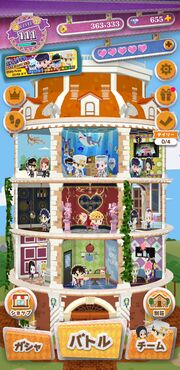
Players have their own JoJo mansion with several rooms that they can decorate with collectable items and props. The characters residing in each room can also be chosen, and they will interact with each other. The player is able to set a roommate if the owner of the room has reached Skill Level 5.
The mansion resets 3 times a day granting the player additional experience points and coins. Following the reset 3 room interactions refresh for the player to collect. Room interactions grant point and experience whilst a visit to an another player grants a heart or one diamond depending if the players follow each other.
The shop menu is located in the bottom left corner, above the gacha menu. In the menus all of the available shop furniture, premium shop furniture, openable chests, the option to buy diamonds with real money and Event Point Shop can be found. The Event Point Shop has event shops which use special currencies. The Sticker Ink Shop and Decorative Sticker Ink Shop are always present.
The players used to be able to buy a JoJo Pass, which was a purchasable monthly pass that gave diamonds to the players daily. It contained some additional bonuses, like 1 more Adventure and being able to give 4 gifts a day to a character instead of 3. It has been discontinued on June 1, 2021.
Premium Rooms and Villa
On patch 2.7, the player is given access to a three floored eighteen room villa in which they can display their characters. Each floor has its own Premium Room displaying the six characters placed on each floor of the villa. Premium Rooms have their own unique furniture which can be bought with Furniture Points and Furniture Tickets. At Mansion Level 80, the second villa floor unlocks, and at Level 90, the final floor unlocks.
See here for the full list of furniture.
Adventure and Friendship
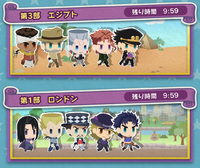
On patch 2.5.3, "Adventure" and "Friendship" were added to the game. Players can send gifts to characters in their rooms to raise their Friend Level. When the friendship gauge fills up, the player will obtain the character's badge. However, some characters have gifts that they hate, lowering the gauge. Each character has at least two badges, with most characters having three badges and unlockable voiced responses when they receive a gift. These obtainable badges can be used as the player's icon. Up to three gifts can be given to a character per day. The gifts present themselves as bags of 3 sizes or unique items.
Gifts are obtained in Adventure mode. Adventure is a function in which two to five characters can be sent to a certain adventure for a determined amount of time where they'll collect items. After sending them out, the player will be able to automatically receive the items after the indicated hours have passed. The length of the adventure varies depending on the chosen course, but longer adventures will allow players to earn more items at once. The characters are able to find coins, level tickets, gifts and even diamonds or chests on special event adventures.
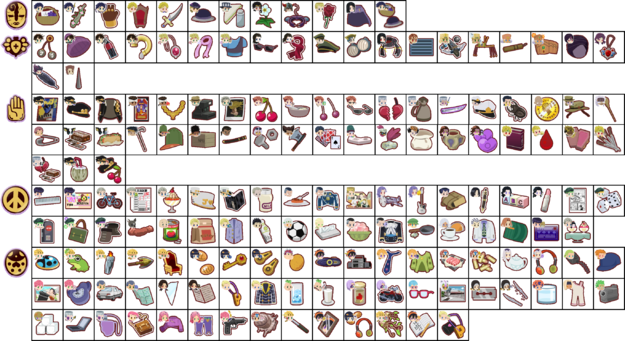
Party
Party is a new feature added in patch 3.1.0 which lets the player's characters party at the top of the mansion. To start a party, the player needs 1000 party coins which can be obtained through challenges. Using an invitation, the player can decide to party with the characters that they picked. Without selecting the characters or without having an invitation, the characters are randomly chosen. During the party, coins and experience obtained in battle will be increased. Each party lasts for 72 hours. However, the player can cancel the party and save up to 48 hours which gets added to the next party started.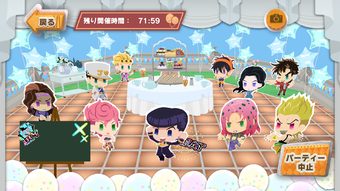
Upon starting a party, a cutscene starts playing which makes all of the characters appear and play animations. The music also changes, which stays playing even in the mansion.
Stickers and Pitter Sets
On patch 2.7.2, Stickers and Pitter Sets were added to the game.
- Pitter Sets: Pitter Sets are stored sets of a team of two characters and Stickers placed on a Sticker Book. Up to nine sets can be stored. Each Pitter Set has a maximum cost of Stickers that can be placed on it based on the rarity of the units in the team (
 The character is a bronze rarity unit&
The character is a bronze rarity unit& The character is a silver rarity unit: +35,
The character is a silver rarity unit: +35, The character is a gold rarity unit: +45,
The character is a gold rarity unit: +45, The character is a double gold rarity unit: +50) The maximum cost is 100 if two
The character is a double gold rarity unit: +50) The maximum cost is 100 if two The character is a double gold rarity unitunits are in a team (120 if they are
The character is a double gold rarity unitunits are in a team (120 if they are The character is a double gold rarity unit+++).
The character is a double gold rarity unit+++).
In the Sticker Book screen, by pressing the filter button in the bottom right corner the game displays only the stickers that have any effect on the team in the Pitter Set. - Sticker Ink (シールインク, Sīru Inku): Sticker Ink can be obtained from events and daily challenges, which can be exchanged for Stickers in the shop.
- Decorative Sticker Ink: Decorative Sticker Ink can be obtained from reaching certain score milestones every Score Attack season, 220 in total per season. It's exclusively used for buying Decorative Stickers from the Decorative Sticker Shop.
- Stickers (シール, Sīru): Stickers allow teams to be enhanced with various bonuses during a battle. For example, "Matching Power + 80" is the effect of one sticker.
- They are divided into five variations: Normal, Shiny, EX (only one can be equipped), Decorations (up to 10 can be equipped), and Backing Paper.
- Some stickers have an activation condition. If the conditions are not met the sticker effect does not activate but still takes up cost.
See here for the full list of stickers.
Awakening
Awakening is a new feature added in patch 3.0.0 where the player can collect Jewels to release the level limit of units. There are three Awakening levels. If the Awakening level is maximized, players will unlock that character's EX sticker for ![]()
![]()
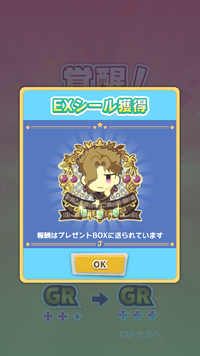
Only certain characters branded as Awakenable are able to be Awakened. It is possible to know which characters are Awakenable by looking at their character profile.
Per each Awakening Level, the character's maximum level increases by ten and maximum sticker cost increases by +2, +3, +5 (+, ++, +++ respectively) on ![]()
![]()
![]()
![]()
![]()
![]()
![]()
![]()
Characters at their maximum level are marked with yellow, highlighted text.
Jewels
Awakening each character requires Jewels, and each rarity requires a different amount of Jewels.
 The character is a bronze rarity unit- 30 Jewels
The character is a bronze rarity unit- 30 Jewels The character is a silver rarity unit- 20 Jewels
The character is a silver rarity unit- 20 Jewels The character is a gold rarity unit- 5 Jewels
The character is a gold rarity unit- 5 Jewels The character is a double gold rarity unit- 5 Jewels
The character is a double gold rarity unit- 5 Jewels
Jewels can be earned by obtaining a unit that the player already owns. However, characters that can't awaken will not give any Jewels. The amount of Jewels received depends on the gacha banner. Diamond gachas give five Jewels, and coin gacha give one Jewel. After update 3.1.3 the player is able to exchange their surplus of Jewels for Level Tickets, 1 Level Ticket per ![]()
![]()
![]()
![]()
Characters
Characters differ in rarity:![]()
![]()
![]()
![]()
![]() in the tables below are limited, appearing only in event Gacha banners,
in the tables below are limited, appearing only in event Gacha banners, ![]() are Festival Limited, being only obtainable in a Pitter Festival Gacha banner, and
are Festival Limited, being only obtainable in a Pitter Festival Gacha banner, and ![]() means they are voiced.
means they are voiced.
A character cannot be put in a team or a room together with a different version of the same character. However, if they are from different parts they can be used.
![]()
Playable
Non-Playable
Unused Content
- Debug Files/Data
- Robert E. O. Speedwagon (V2)
- Old Robert E. O. Speedwagon
- Enya the Hag (V2)
- Anjuro Katagiri (V2)
- Keicho Nijimura (V2)
- Reimi Sugimoto
Events
Event Types

The most common event type is an "Event Card", a 2 sided event featuring event furniture or event stickers. The front is a linear card of 12 sets, 5 stages per set ending with a boss. Upon clearing certain sets the player can obtain the time limited furniture pieces or stickers. Following the front Event Card, in the second half of the event itself a "Gift of Happiness" back card releases. It's a harder card with 6 sets instead of 12 and more valuable rewards and character gifts. Furniture pieces do not appear in them, however shiny versions of the event stickers do.
Shop Event Cards are a very similar event type to regular event cards. They follow the same card structure but give out very few diamonds and chests. However, set rewards still grant limited furniture pieces and all stage rewards are replaced with event points. The shop is much more expansive than the Promotion Shop, featuring infinite battle items, high tier chests, unit duplicates instead of skill tickets and various Gacha Tickets. Every event of this type has themed points (Souls ![]() for Telence T. D'Arby's event, poker chips
for Telence T. D'Arby's event, poker chips ![]() for Daniel J. D'arby's event, orange bombs
for Daniel J. D'arby's event, orange bombs ![]() for Oingo and Boingo's event and cherries
for Oingo and Boingo's event and cherries ![]() for Rubber Soul's event).
for Rubber Soul's event).

Additionally, a rare Event Card "Ora Ora Cheering!" rarely appears when a limited unit releases. It grants much less rewards than usual, but it features one of the units 60 character skill tickets.
Another common event is "Formidable Enemy". Formidable Enemy events are simple, 3 stage cards with a single boss that becomes harder every stage. It yields 60 000 coins for first clear of all 3 stages and maintains the highest coins base in the game (at stage 3). The bosses usually cover most of the board with obstacles and have up to 800 000 health points.
Lastly, the "Event Bingo" is a common event type with many forms. It's a 5x5 grid with objectives, which when fulfilled in a line grants the player a bingo, and a reward based on how many bingo's the player already gotten. In the permanent card section there are 3 bingo boards in one card with varying difficulty of the tasks. The game also releases Promotion Bingo Cards, which grant the player Promotion Points for the Promotion Point Shop. The player is able to buy all kinds of items, including character specific skill tickets and battle items. Rarely, an Event Bingo becomes the main event card.
A training stage can also be found in the permanent card section called Trial Practice Ground. The player is allowed to test out unit combinations without spending hearts. The stage contains no obstacles or effects and lasts for 60 seconds. The player cannot use battle items. The stage repeats itself five times and after the last attempts time depletes, the board freezes and the player is unable to match or use skills. Upon going into the pause menu, the player can see their data in all five attempts separately, such as damage, stand-ups entered and highest combo. The stage cannot be completed and forces the player to quit the stage manually. The permanent event section also contains a "Let's go Experience Hunting!" card, which gives large amounts of experience points for characters.
Gacha Types
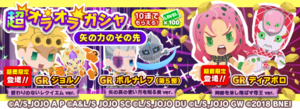
There are multiple kinds of Gacha that change depending on its contents. The types are mostly dictated by the kind of units present on the banner, if it distributes rewards on tenfold summons and how it functions.
- Premium Gacha - All featured units are not limited with no additional rewards on a tenfold.
- Super Rate Up Premium Gacha - A Premium Gacha with very high rates for the featured unit.
- Ora Ora Gacha - At least one of the featured units is limited, includes additional rewards on a tenfold.
- W Ora Ora Gacha - At least one of the featured units is a
 The character is a double gold rarity unit. Sometimes includes tenfold stamp rewards, granting additional items and even featured units.
The character is a double gold rarity unit. Sometimes includes tenfold stamp rewards, granting additional items and even featured units. - Super Ora Ora Gacha - At least one of the featured units is limited, includes additional rewards on a tenfold.
- Step Up Gacha - A Gacha with 5 steps and no limited featured units, which has different diamond cost each step. The steps also have additional bonuses, like a guaranteed
 The character is a gold rarity uniton step 3. On the fifth step the player is guaranteed to receive one of the featured units on the last draw of the tenfold.
The character is a gold rarity uniton step 3. On the fifth step the player is guaranteed to receive one of the featured units on the last draw of the tenfold. - Mini Step Up Gacha - A Gacha with 3 steps, which functions the same as a normal Step Up Gacha with fewer steps.
- Special Step Up Gacha - A Step Up Gacha with at least one limited featured unit, can contain
 The character is a double gold rarity unitunits. It functions the same as a Step Up Gacha.
The character is a double gold rarity unitunits. It functions the same as a Step Up Gacha. - Pitter Fest Gacha - A Gacha with all Festival Limited characters, includes tenfold stamp rewards.
There are also unique, special banners such as "1 Year Anniversary Thank You! Gacha" and "New Year's Super Ora Ora Gacha" which function on their own, special event conditions (for example distributing Gacha Tickets for other Gachas).
Major Rotating Events
The events in this category are present at all times and rotate monthly and seasonally.
Special Battle
Special battles are unique, one time events which include a mini-game card. Characters skills cannot be used, the damage is set to very low values, the partners skill gauge is blocked and the leaders gauge is replaced with a special, pink, mini-game gauge. The effects of the gauge depend on the Special Battle. The players can obtain tickets from associated event cards and play them for time limited rewards.
The Rock-Paper-Scissors Battle tickets were available on the "Rock-Paper-Scissors Kid is Coming!" event related cards.
When the player scored a Home Run the next ball was thrown immediately, stopping after a failure or winning the battle.
The Batter Battle tickets were available on the "Decisive Battle, The Miasma of the Void" and "Decisive Battle, The Mystery of The World" event related cards.
Gallery
Videos
Trailers
Duration: 0 seconds.Duration: 0 seconds.Duration: 0 seconds.
Other
Trivia
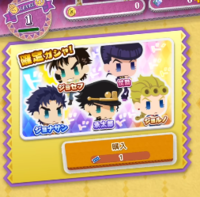
- Initially during the release of the game the JoJo Banner featured an early design of Giorno matching his JOJO-D color scheme. This banner image was swapped with the anime's colors in subsequent updates.

























